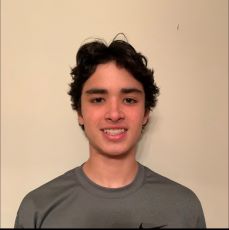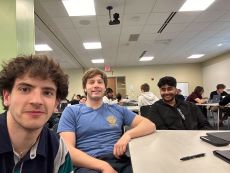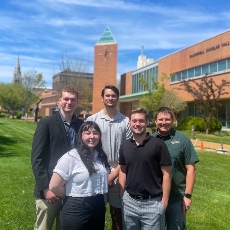Engineering Senior Design Projects
During the fall and spring semesters of their senior year, students at Saint Louis University School of Science and Engineering participate in a capstone experience called Senior Design.
Students form teams to research, design, and even produce a prototype of an original system of their own design. These courses bring together many concepts that were introduced in the undergraduate curriculum.
2024 Student Projects
 ASCI-4350 Project
ASCI-4350 Project
Lucas Batson, Noah Hanson, Josh Idzikowski, Benjamin Niederer, Sebastian Valenzuela
The purpose of this research study is to shed light on the operations and accident history of small and large airports in respect and comparison to each other. This will help to acquire a better understanding of what factors lead to aircraft accidents and how they can be better prevented.
Exhibit #26
 ATC Suicide Rates
ATC Suicide Rates
Abdullah Alasmri, Mohammed Alfawaz, Tyler DeBettignies, Darren Mushkin, Hudson Pettit, Minsu Song
Mental health is a crisis today, and the aviation industry has no shortage. Air traffic controllers are vital to the successful operation of every flight every single day. Finding ways to support air traffic controllers in their extremely stressful job needs to happen, and one of the first steps is determining some of the factors. Our group wants to study and identify possible casualties of stress and mental health crises for air traffic controllers, and how to prevent them.
Exhibit #25
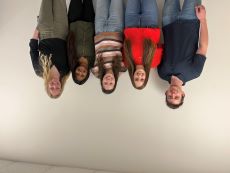 Pilot Fatigue
Pilot Fatigue
Grace Appelbaum, Matthew Liguori, Mallory Machala, Hafsa Mou and Rebecca Treis
This study aims to identify the cognitive and psychomotor impairments that pilots can experience due to sleep deprivation and how those impairments can impact decision-making abilities in stressful environments such as those encountered in emergencies. Our study aims to show the effects of sleep deprivation on pilots and how it affects them in stressful situations on the flight deck. That encompasses multiple avenues of situations, such as effective teamwork, correctly going through the entire checklist, split decision-making, and so on. The ability to perform these tasks perfectly is complex, and adding fatigue to this equation opens pilots up to making errors. In a high-consequence environment, errors such as not following the checklist could have devastating consequences..
Exhibit #24
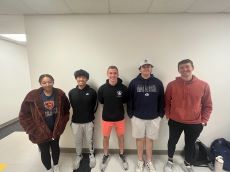 Effect of Flight Management Systems on Pilot Performance
Effect of Flight Management Systems on Pilot Performance
Arianna Brown, Troy Ettenson, Michael Jonell, Kevin Rhee, Alexander Speer
This study aims to introduce flight management systems and how these systems affect pilot performance relating to response time, workload distribution, and situational awareness within critical phases of flight and the impacts it has on aircraft safety.
Exhibit #23
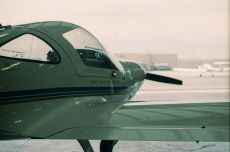 Analyzing the Evolution of Flight Crew-ATC Communication: Lessons from Preceding Aviation
Accidents and Implications for Training and Protocol Enhancement
Analyzing the Evolution of Flight Crew-ATC Communication: Lessons from Preceding Aviation
Accidents and Implications for Training and Protocol Enhancement
Savannah Baker, Jack Liu, Nolan Mank, Ricardo Romero, Tinghao Zhang
Looking to the twenty years preceding Avianca Flight 52, what aviation accidents existed in that time frame that regarded miscommunications between flight crews and air traffic controllers? How did those incidents influence the protocol and training procedures within this accident, and what factors were not accounted for? How did those failures influence communication between flight crews and ATC for the next ten years?
Exhibit #22
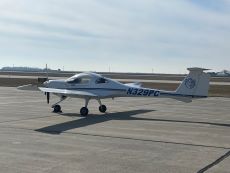 Airline Organizational Culture and Its Correlation to Aviation Accidents
Airline Organizational Culture and Its Correlation to Aviation Accidents
Mary Cortesi, Yichen Liu, Woo Cheon Park, Ellie Volansky, Bojian Yu
Our research will focus on investigating the relationship between airline organizational culture and aviation accidents between 2010 and 2024, in order to understand how basic beliefs, practices, and values within aviation organizations affect safe operations. We will study specific aspects of organizational culture, such as leadership style and communication practices and the connection between them and the frequency and severity of aviation accidents. And we will report what we can be learned from accidents caused by distrust or power imbalance among crew members in the past? How do these events affect changes in aviation policies, procedures, and training? So as to reduce the possibility of future accidents.
Exhibit #21
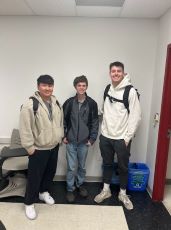 Influence of Organizational Culture on Aircraft Safety
Influence of Organizational Culture on Aircraft Safety
Addison Brazile, Nicholas Carey, Mike Morell, Jongchan Park, Will Weaver
Aviation safety has been an integral part of the industry for as long as it has existed. However, it has been a reactive type of safety, instead of a proactive type. We wanted to look into what exactly causes that in different companies and organizations. Specifically with Boeing, ValuJet, Southwest, and other aviation corporates, we hope to find interesting information when we look into these. Potentially shedding some light on what exactly is going on behind the scenes in these operations.
Exhibit #20
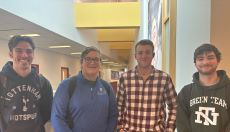 How the FMC, ADS-B, and ACARS is Affecting Safety and Efficiency of Air Transport
Operations
How the FMC, ADS-B, and ACARS is Affecting Safety and Efficiency of Air Transport
Operations
Sebastian Conklin, Jonathan Faust, Jack Haduch, Ryan Sherman, Edwin Wangui
A meta data analysis of how modern cockpit technologies such as Flight Management Computers(FMC), Automatic Dependent Surveillance-Broadcast(ADS-B), and Aircraft Communications Addressing and Reporting System(ACARS) affect safety and efficiency of the modern commercial aviation system. How these technologies foster improved communication between pilots and dispatchers, facilitating safer and more efficient flight operations by enabling real-time data exchange, automating routine tasks, and providing critical flight information, which collectively contribute to the optimization of airline operations.
Exhibit #19
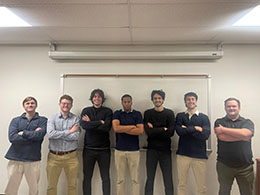 Chuck's Chompers
Chuck's Chompers
Atticus Edge, Ben Haukap, Alfonso Morales, Maksim Juric, Gavin Ryan, Shayne Murphy, Michael Davies, Shiyan Nejat
Your print failed, and once again all of the filament you purchased has gone to waste. What should you do? Typically, many individual users of 3D printers are forced to buy more filament or send their failed prints off to larger recycling companies, as traditional desk size recycling systems range from $6,000 - $18,000.
Chuck’s Chompers decided that we wanted to find a way to design an affordable recycling system to safely recycle used filament and failed prints. Hence, the goal of our project (R3fil) is to design an automated machine that will perform grinding, heating, extrusion, and automatic spooling to recycle 3D filament while also being small enough to be used in an individual setting.
Exhibit #7
 Energy STL
Energy STL
Kevin Noonan
The assessment of energy efficiency and availability in the city of Saint Louis and the metro area. We will be using exergy as our key analytical tool. Using exergy analysis provides a unique perspective by evaluating the quantity and also the quality of energy.
Exhibit #12
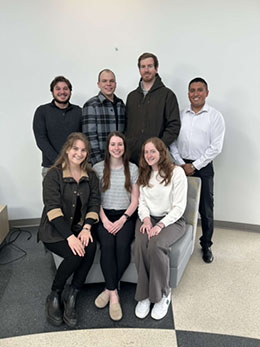 LegUp
LegUp
Armando Alvarado, Katrina Esswein, Regan Ford, Rob Guetterman, Jake Little, Sophie Maloney, Logan Radick
LegUp aims to be an assistive device for individuals with a temporary foot or ankle injury. Current market options are typically uncomfortable and inconvenient and make the recovery process difficult. Our project is a hands-free device that is supportive and stable for a range of users and will allow them to walk with a more usual motion.
Exhibit #13
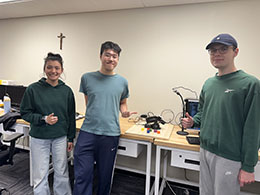 Natural Language Control for a Robotic Arm
Natural Language Control for a Robotic Arm
Lucy Billadeau, Pascal Sikorski, Kaleb Yu
In this project, we introduce an approach for controlling robotic arms through natural spoken language. Unlike traditional methods that rely on a predefined set of explicit commands, our system is designed to interpret the user's intent. By leveraging Large Language Models, the system is able to process human speech and draw upon the appropriate robot action. This advances verbal control of the robotic arm such that it will be able to execute tasks with precision and flexibility given complex verbal instructions.
Exhibit #27
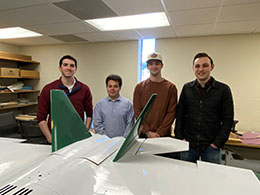 Project MAAV-eRIC: Maneuverable Autonomous Aerial Vehicle enabling Research in Intelligent
Controls
Project MAAV-eRIC: Maneuverable Autonomous Aerial Vehicle enabling Research in Intelligent
Controls
Connor Fadden, Joshua Nguyen, Jacob Stukas, Xavier Torres Arpi
Our mission is to design, build, and flight test a single engine, twin tail, radio controlled, test bed capable of acrobatic maneuvers for control system research purposes. MAAV-eRIC is a senior design team at Saint Louis University that is currently developing an unmanned aerial vehicle (UAV) as a future testbed platform for the AirCRAFT Lab under the supervision of Dr. Srikanth Gururajan. Dr. Gururajan and the AirCRAFT desire a maneuverable aircraft that can be used to study control algorithms and the dynamics of an aircraft performing a variety of maneuvers. The aircraft will be a twin-tailed single turbine powered platform with a multitude of data collection equipment. The customer calls for reliable aircraft meant to be repetitively flight tested and gather as much data as possible. Once built MAAV-eRIC will be used for years into the future to facilitate research and learning in the Saint Louis University School of Science and Engineering AirCRAFT Lab.
Exhibit #8
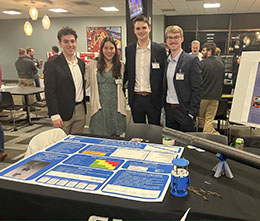 Project RADARS (Rocket Altitude Determination and Response System)
Project RADARS (Rocket Altitude Determination and Response System)
Colin Cummins, Tim Drake, Matthew Muetzel, Mary Otten
Every year, collegiate rocketry propulsion teams participate in nationwide competitions, such as, the Spaceport America Cup and NASA Student Launch. These competitions have various altitude requirements that the student-designed and built rockets must reach, in order to qualify. Teams will often use solid rocket motors for these competitions, which are not controllable once launched. However, this is where issues may arise, due to the various motor and atmospheric differences between initial testing and the competition launch. Project RADARS, Rocket Altitude Determination and Response System, aims to resolve this problem by integrating a dynamic altitude control system onboard the rocket. The system is a minor air braking mechanism that will autonomously extend or pull back flaps, either increasing or decreasing the drag and thus controlling the altitude.
Exhibit #6
 RAPTOR
RAPTOR
Lesly Aguilar, Sarah Brzezinski, Michael Dompke, Justin Ndacaisaba, Will Ryan, Andrew Stack
RAPTOR, developed by MechFly, is a cutting-edge project aimed at excelling in the ASME IAM3D Unmanned Aerial Racing Cargo Vehicle (U.A.R.C.V.) competition. This competition challenges university students to harness additive manufacturing and iterative design techniques to craft an unmanned aerial racing vehicle capable of efficiently handling cargo. The mission? Pick up and deliver payloads in a thrilling racing environment. With up to five drones racing simultaneously, RAPTOR aims to showcase agility, speed, and precision as it navigates the course, demonstrating its capability to swiftly pick up, travel with, and drop off multiple payloads from designated areas. Through meticulous design processes and detailed documentation, MechFly endeavors to stand out in both performance and innovation in this exhilarating competition.
Exhibit #5
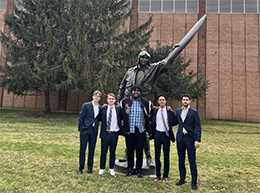 RAPTOR
RAPTOR
Carlos Torelli, Jerome Quebbeman, Michael Maxwell, Hogan Jones, Pablo Izquierdo
The RAPTOR mission aims to rapidly deploy a 12U CubeSat from an F-15E aircraft with less than 24 hours' notice, addressing gaps in space-based PNT, communications, and ISR systems. This initiative enhances space-based services for special operations, increasing military agility and effectiveness. The mission involves receiving a request, constructing and attaching the payload to RAPTOR, deploying it from the F-15E at 40,000 feet, and executing an organized payload deployment and potential recovery.
Exhibit #4
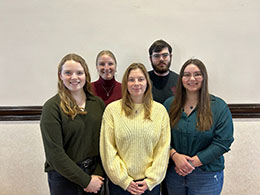 Self-Launch Sailplane Utilizing Electric Driven Propulsion
Self-Launch Sailplane Utilizing Electric Driven Propulsion
Spencer Cochran, Sophia Collins, Amanda Kohne, Isabel Korzilius, and Camilyn Newbanks
Sailplanes, also known as gliders, are aircraft with no propulsion system. This project utilizes a self-launching propulsion system which are often powered by small jets, pistons, rotary or electric engines. The project requirements for an electric powered self-launching aircraft are broken into the subcategories of performance, design, manufacturing, and operation. The requirements for this design were selected from the 2023-2024 AIAA Electric Training Sailplane RFP, but not all requirements from the RFP will be applied. The design of this electric sailplane will be made up of two phases. The first phase includes the design and computations for a full-scale theoretical model. The theoretical model, with its 20 meter wingspan, will utilize computer modeling and ANSYS Fluent simulations to verify the aircraft’s performance. The second phase consists of the design, construction and flight of a test flight model. This flight model will be constructed as a scaled version, 4 meter wingspan, of the theoretical model to test the model’s configuration with a retractable propulsion system.
Exhibit #10
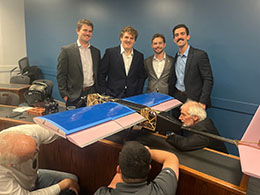 Team Oliver Design Build Fly
Team Oliver Design Build Fly
Luke Giunta, Antonio Hamilton, James Kramer, Peter Trainor
The mission of Team Oliver is to design, build, and fly a compact aircraft that is fully compliant with all AIAA requirements set out in the 2024 AIAA Design Build Fly competition. The aircraft shall be designed utilizing the optimized scoring equation variables from Missions 2 and 3 and configured to be repurposed for the three outlined urban missions. The team goal is to complete a moderate risk development effort, submit a design report, and fly the completed aircraft at the April 2024 DBF competition in Wichita, KS.
Team Oliver has completed 2 of their 3 planned plane models and successfully flew their first plane, without crashing, on December 9th, 2023. They are in the process of building their next version which has a predicted dry weight reduction of 30%, enabling an increase in payload by 2458.47 grams and a more longitudinally and laterally stable aircraft that its previous iteration.
Exhibit #9
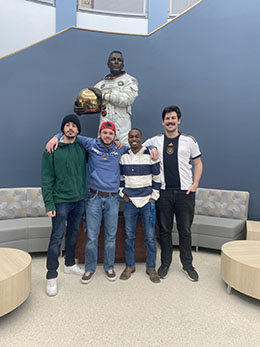 The Belly: Long Range Cargo Aircraft
The Belly: Long Range Cargo Aircraft
Cordan Hampton, Robert Immekus, Tavin Matiszik Endrit Mehmetaj
The Belly is a conceptual design for a modern cargo aircraft to be used by the United States Air Force. The project was presented to the team with the goal of creating a long range aircraft capable taking off and landing on short runways. The aircraft is designed to be flown autonomously and carry a payload of a single standardized 463L pallet.
Exhibit #11
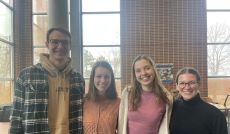 DextraGrip
DextraGrip
Grace Almgren, Abby Kieffer, Ryan Mueller, Angie Romanelli
Our project is a rehabilitation tool to assist patients suffering from brain or stroke-related paralysis via hemiparesis. The device aims to provide functionality via an external mobilization of the hand through an EMG-motorized orthosis system that allows for dual mode for opening and closing of the hand. Additionally, there is an integrated sensory feedback system that allows the user to modulate the amount of pressure applied when attempting to perform certain functions, such as picking up a soda can.
Exhibit #67
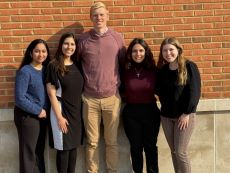 Fluidix - Lymphedema Treatment Device
Fluidix - Lymphedema Treatment Device
Julia Brockhouse, Ether Dharmesh, Ryan Hilty, Jessica Robinson, Saloni Shringarpure
Each year, 1 in 1000 Americans suffer from lymphedema, a build-up of lymph fluid in the fatty tissues under the skin causing swelling and discomfort. Lymphedema pump devices have been proven to reduce swelling through at-home usage, but they do not match the superior effectiveness of lymphatic massages delivered by physical therapists. Such suboptimal efficiency extends the time patients spend in each pump treatment session, and this inactivity worsens lymphedema. Here, we have developed a pneumatic pump device to push fluid back into lymphatic vessels through sequential pumping from foot to groin, with segmented bladders that inflate from the back to the front of the leg to emulate a physical therapy massage. Pressure sensors embedded in the sleeve of the device allow precise measurement of the applied pressure and adjustment of the degree of inflation. This design is simultaneously adjustable and effective, allowing for patient-directed treatment without compromise of quality.
Exhibit #71
--
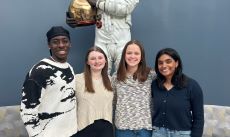
MIHeight
Abigail Bremseth, Amanda Deja, Joshua Nuka, Raina Panicker
MIHealth revolutionizes self-awareness and healthcare through innovative reflection. MIHealth is a smart mirror that can determine a user's height, weight, and temperature. It utilizes sensors all around the mirror's frame to accurately determine the user's data and display the results on a LCD screen hidden behind the frame.
Exhibit #74
 MindTrack - Cognitive Change App
MindTrack - Cognitive Change App
Lexxy Ahn, Ben Schneider, Ben Sloan
At MindTrack, we are on a mission to empower individuals through proactive testing for early detection of cognitive decline and to provide peace of mind to the aging and their loved ones. Our app provides interactive screening exercises, personalized content, and intuitive incident tracking to offer a holistic approach to cognitive health. We believe in prolonging quality of life through evidence-based progress tracking that enhances cognitive resilience. Join us in redefining cognitive care—because a sharp mind is a lifetime asset.
Exhibit #69
 Optimization of Electrospraying for the Creation of Large Diameter Microsphere for
Vessel Occlusion
Optimization of Electrospraying for the Creation of Large Diameter Microsphere for
Vessel Occlusion
Rose Viguerie
This project aims to optimize the creation of PEG microspheres via electrospraying for use in several applications, one being vessel occlusion at the site where they are injected. The primary variable tested, the needle gauge, will be varied to obtain microspheres in a range of 100μm to 500μm while having a coefficient of variance lower than 20% (ideally around 10%). If time permits, further variable analysis will be performed (such as considering varying the voltage between the needle tip and the oil bath). After the microspheres’ physical parameters have been tweaked to fit the requirements, injection testing will be performed. The microspheres must be able to be injected via an insulin needle without aggregation occurring (this would interfere with the process of injection). The data gathered in this experiment will serve as a guideline for further electrospraying research by providing expected values for diameter.
Exhibit #66
 Piezoelectric Hydrogels
Piezoelectric Hydrogels
James Baker
Biocompatible piezoelectric materials are a growing area of interest for biomedical engineering researchers for their potential rehabilitative and regenerative properties for electrically excitable cells. By further developing these materials, it may be possible to use them to better address issues such as volumetric muscle loss and nerve damage. For researchers to produce these piezoelectric devices, they must be able to robustly validate these materials as reliable forms of treatment. To accomplish this, researchers need systems that can measure the electrical properties of materials created in the laboratory before moving to clinical settings. Researchers often run into the problem that systems used for detecting
small currents produced by these materials are too expensive or too big for practical use. This project demonstrates the successful synthesis of Poly(vinylidene fluoride)-poly(ethylene glycol) hydrogels and proposes a low cost, portable design for a device to measure electric currents produced by piezoelectric hydrogels.
Exhibit #65
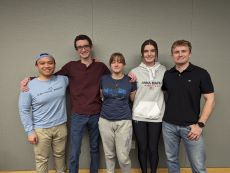 Robotic Prosthetic Hand
Robotic Prosthetic Hand
Talon Krieger, John Melulis, Gerard Peña, Natalie Phelps, Katie Woehlert
The Robotic Prosthetic Hand project features the design and manufacturing of a myoelectric hand prosthetic focused on closely mimickin
g the form and functionality of lost upper extremity limbs for transradial amputations. The prosthetic features a full hand, which attaches to the amputee's prosthetic socket, with independently actuated fingers. Finger actuation includes an electromyogram (EMG) sensor on the residuum limb that measures muscular activity to use as an input to trigger the intended physical responses of the prosthetic hand through embedded microprocessors and servo motors.
Exhibit #70
 Shear Wave Tensiometer for Achilles Load Measurement in Animal Models
Shear Wave Tensiometer for Achilles Load Measurement in Animal Models
Patrick Hinkle
Shear wave tensiometry is a recently developed technique to directly measure in-vivo muscle-tendon loading in humans noninvasively by tracking the velocity of propagating
shear wave vibrations within a tendon to evaluate muscle-tendon loading. Though a proven technique in quantifying muscle-tendon loading in humans, shear wave tensiometry has not been scaled for use in animal models. A rodent animal model is an ideal platform for developing a shear wave tensiometer, but there are many challenges due to the size constraints of a rodent Achilles tendon. By mounting sensors to measurement probes in a free-floating support structure above the animal, the size constraints can be mitigated. The successful development of the device will allow future studies on changes in in vivo muscle function due to injury and potential treatment protocols for these injuries.
Exhibit #75
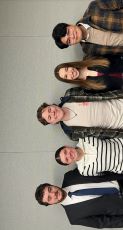 SmartCane Technology
SmartCane Technology
Robert Bucks, Megan Chermack, Owen Miller, Jonel Olar, Cati Welby
Smart Cane aims to satisfy our goals of increasing both safety and independence for the large percentage of the population that rely on the use of canes for walking assistance. With this device, injuries can be prevented, and help will be alerted in the event of a fall. Our design utilizes Inertial Measurement Units (IMUs), which have the ability to track velocities and accelerations using the combination of a built-in accelerometer and gyroscope on a three-axis coordinate system. The IMU works hand-in-hand with a SMS radio to allow for SMS text messages to be sent from the cane directly to any cellular phone. With the combination of an IMU and SMS radio, the cane is capable of accurately sensing when a fall occurs and sending an immediate text message to a pre-selected emergency contact.
Exhibit #72
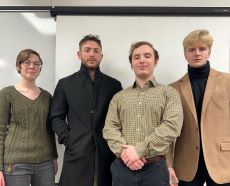 SmartWeight System
SmartWeight System
Dimitri Loli, Caroline Murphy, Almar Myrtaj, Sam Silva
Geriatric patients can face generalized weakness and muscle wasting. In order to combat these conditions, we developed an exercise prescription measuring device to help older adults. It can measure patient repetitions, average speed of motion, and workout time for a simple sit-to-stand variation of the well-known squat exercise. These data points are transferred to an Android application from our sensor over Bluetooth. From there, workout information can be sent to a database for physician or care practitioner use.
Exhibit #73
-------
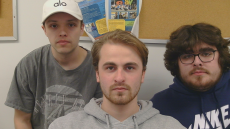 ROB Project
ROB Project
Robert McManus, Brandon Terselic, Noah Whetstone
Our project's purpose is to inspire the next generation of engineers. We wish to plant a seed of curiosity and excitement in the minds of high school students touring SLU through the engineering and design of ROB. ROB is a mobile robot which gives a tour of Saint Louis University's McDonnel Douglas Hall.
Exhibit #68
-------
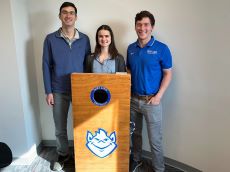 WaveBags
WaveBags
Michael McCormick, David Ruetten, Rebekah Weimholt
Our senior design project focuses on innovating the classic game of cornhole by incorporating an electronic scoring system through RFID (Radio-Frequency Identification) technology. This project aims to improve the gaming experience by eliminating manual scoring, giving players a seamless and automated scoring process. The cornhole boards are equipped with several antennas that read chips that are embedded in each of the cornhole bags. As the cornhole bag is thrown onto the boards, the RFID technology will be received and will accurately record the score following the throw of the final black cornhole bag. This system will not only add a technological edge to the traditional game of cornhole, but also will introduce a more efficient and engaging way to play the popular recreational game.
Exhibit #76
 β-mannosylation by hydrogen-bond-mediated aglycone delivery
β-mannosylation by hydrogen-bond-mediated aglycone delivery
Cece Fitz
Stereocontrolling the glycosylation reactions is a constant quest in the field of glycosciences, and often proves to be quite cumbersome. The hydrogen-bond-mediated aglycone delivery (HAD) method provides control of the stereoselectivity in the glycosylation of a variety of sugar substrates, allowing for the formation of difficult 1,2-cis glycosides. The HAD method relies on the formation of an intermolecular hydrogen bond between the nitrogen atom on the protecting group of the glycosyl donor with the hydroxyl group of the glycosyl acceptor. This interaction allows for a subsequent syn-attack by the approaching nucleophile, allowing to achieve a powerful stereocontrolling mode for the glycosidic bond formation. Reported herein is the synthesis of a novel mannosyl donor capable of HAD and its applications in glycosylation.
Exhibit #46
-----
Brimstone Life
Robert Mendoza
This project presents different internal standards in deuterated sulfuric acid as a solvent for reactions using NMR as a quantitative tool. Strong acids such as concentrated sulfuric acid is known as dehydrating agent, a strong oxidizing agent, and can destruct complex molecules. This project investigates the stability, reactivity, and solubility of internal standards in a sulfuric acid solvent system.
Exhibit #39
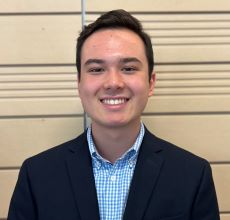 Characterization of Photoreactive Dibenzothiophene Sulfoximine Derivatives
Characterization of Photoreactive Dibenzothiophene Sulfoximine Derivatives
Nicolas Keller
The Bolm-McCulla reaction describes a photolysis of dibenzothiophene sulfoximine which yields two reactive intermediates via S–N and S–O bond cleavage. Photocleavage of DBT sulfoximines releases a nitrene product followed by atomic oxygen [O(3P)] upon irradiation with UV-A light. Studies of O(3P) in solution have been hindered by the high energy photons needed to generate this intermediate from known methods. Additionally, previous work by the McCulla group has demonstrated that the rate of reactive atomic oxygen release may be altered by the electronic effects of substituent groups placed on DBTO. A water-soluble molecule 4,6-diacetoxymethyl DBT sulfoximine has been synthesized which may produce O(3P) and nitrene upon photolysis. Further investigation of this process can contribute to building a framework for the development of additional chromophores capable of releasing two distinct reactive intermediates in a specified order.
Exhibit #40
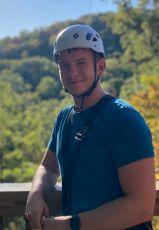 Chemical Synthesis Of 3-Fucosyllactose, An Iimportant Human Milk Oligosaccharide
Chemical Synthesis Of 3-Fucosyllactose, An Iimportant Human Milk Oligosaccharide
Joey Wise
Human milk oligosaccharides (HMO) are very important and the third most abundant constituent of human milk component after lactose and lipids. They are a structurally and biologically diverse class of glycans. Developing new methods for the chemical synthesis of HMO has been an active area of research. One way of synthesizing glycans in general and HMO in particular is application of thioglycoside building blocks. Many thioglycosides are known, and among these S-benzoxazolyl (SBox) found some application to the synthesis of various glycans. As a part of our ongoing efforts toward the development of novel methods for glycosylation and glycan synthesis, presented herein is our discovery that SBox donors are excellent substrates for the synthesis of HMO. That is because the SBox glycosides can be activated over other thioglycosides with excellent yield and stereoselectivity. The initial studies dedicated to the synthesis of simple glycosidic linkages and investigation of the reaction mechanism have now been extended to the streamlined synthesis of 3-fucosyllactose, a common HMO trisaccharide found in human milk.
Exhibit #41
 Cooperatively-Catalyzed Koenigs-Knorr Glycosylation for Complex Glycan Synthesis
Cooperatively-Catalyzed Koenigs-Knorr Glycosylation for Complex Glycan Synthesis
Chau Ta
Reported herein is an expansion of a recent development in glycoscience, namely the formation of glycosidic linkages under cooperatively catalyzed Koenigs-Knorr reaction conditions, to glycan synthesis. Previously, cooperatively-catalyzed Koenigs-Knorr glycosylations was a multi-step procedure that relied on the formation of a glycosyl halide intermediate with interim drying and evaporation. The optimized glycosylation can now be achieved in a single step in the presence of molecular iodine, silver sulfate, and triflic acid. This methodology has been applied to the synthesis of a novel, complex trisaccharide in a 1 + 1 + 1 fashion. Our synthetic approach comprised alternating deprotection and glycosylation steps.
Exhibit #42
 Determining Bond Dissociation Enthalpies of Sulfoxides: What computational method
best predicts experimental values?
Determining Bond Dissociation Enthalpies of Sulfoxides: What computational method
best predicts experimental values?
Sydney Lahm
Computational analysis was conducted to determine the bond dissociation enthalpies (BDE) of S=O bonds in eight molecules, which were subsequently compared to their experimentally derived BDEs. Computational BDE calculations were conducted utilizing various combinations of density functional theory (DFT) and basis sets. Specifically, DFT methods including M06-2X, mPW1LYP, ωB97X-D3, PBE0, and B3P86 were paired with basis sets def2-TZVP/J, def2-TZVP, aug-cc-pV(T+d)Z, 6-311++G(2df,2p), and def2-QZVP. The comparison between computational and experimental BDEs was evaluated through graphical representation, yielding slope and coefficient of determination (R2) metrics. Among the methods tested, mPW1LYP/aug-cc-pV(T+d)Z, PBE0/def2-TZVP, and B3P86/aug-cc-pV(T+d)Z performed best in terms of assessed metrics. Additionally, comparative analyses were expanded to include complete basis sets methods (CBS-QB3 and CBS-4m), which, exhibited comparatively lower accuracy in predicting experimentally calculated S=O BDEs compared to the combination methods.
Exhibit #43
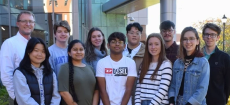 Experimental Determination of Thermodynamic Parameters for Pseudouridine-Guanine Pairs
in Duplexed RNA: Terminal Mismatches, Tandem Pairs, and Bulge Loops
Experimental Determination of Thermodynamic Parameters for Pseudouridine-Guanine Pairs
in Duplexed RNA: Terminal Mismatches, Tandem Pairs, and Bulge Loops
Sebastian J Arteaga, Julia W Stone, Brent M Znosko
Pseudouridine (Ψ), an isomer of uridine where the nucleobase is attached to the C1 of the ribose sugar via C5 rather than the standard N1, results in an additional hydrogen bond donor which can increase the stability of RNA. Ψ has been found to affect tRNA, rRNA, and snRNA function. This project aims to investigate the thermodynamic parameters of G-Ψ pairs in various secondary structures to allow the incorporation of Ψ in secondary structure prediction algorithms. Data from optical melting experiments of selected oligonucleotides were analyzed to determine average ΔH˚ , ΔS˚ , ΔG˚ 37, and Tm for each and compared these to their canonical counterpart. As expected, the addition of Ψ has been found to be stabilizing to a degree proportional to the number of Ψ in each sequence. These thermodynamic parameters can be used to predict likely secondary structure of RNAs containing Ψ improving RNA technology design ability.
Exhibit #44
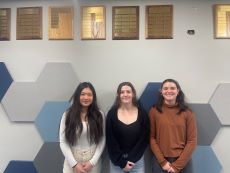 Exploration of GPR183 Antagonist Derivatives for the Treatment of Neuropathic Pain
Exploration of GPR183 Antagonist Derivatives for the Treatment of Neuropathic Pain
Olivia Farris, Elise Stuertz, Ivy Yang
Neuropathic pain presents multiple unique challenges for clinical treatment. Current treatment guidelines include prescription of tramadol, tapentadol, and other low-dose opioids. The efficacy of opioids for neuropathic pain has been called into question, along with obvious concerns regarding addiction and over-prescription. Alternatives to opioid-based treatments include neuromodulation, treatment with tricyclic antidepressants, and serotonin and norepinephrine reuptake receptors (SNRIs). While these treatments show some clinical efficacy, the lack of knowledge of their mechanisms of action has slowed the development of potentially more efficacious treatments. Thus, elucidation of the pathways involved in neuropathic pain is essential for research into the next generation of neuropathic pain treatment. Transcriptomic screening revealed that upregulation of GPR183 is pronociceptive. Oxysterol, 7α,25-dihydroxycholesterol, an endogenous GPR183 ligand, produces such upregulation upon binding. A previously discovered inhibitor for GPR183 has been shown to reverse critical constriction injury (CCI)- induced neuropathic pain in mice. Taking advantage of the structure-activity relationship revealed by this research, selected cinnamic compounds are now being explored as part of GPR183 inhibitor derivatives that seek to produce increased bioavailability.
Exhibit #38
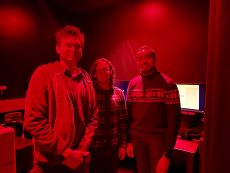 Exploring reverse migration in 2D and 3D environments using subcellular optogenetics
Exploring reverse migration in 2D and 3D environments using subcellular optogenetics
Aditya Chandu, Ajith Karunarathne, Waruna Thotamune
Cell migration is essential to the dynamic processes throughout the body such as wound healing and embryonic development. Fluid viscosity, concentration gradients, flow rate, and the presence of other cells or compounds are external factors that alongside internal factors like expression of adhesion molecules, intracellular pathways, and membrane tension, affect the cellular movement. Current literature has established that GPCRs play a unique role in cellular migration. Using typically adhered cells seeded on glass-bottomed dishes, iso-dense layers of Ficoll400 to mimic the body’s 3D environment, and GPCRs coupled to light-sensitive GPCR agonists our aim is to unveil the cellular mechanisms behind reverse migration: migration away from stimuli. Advanced microscopic techniques, receptor or agonist photoactivation using confined light, and optogenetic techniques pave our way to exploring and comparing reverse migration to more conventional behavior. A deeper grasp of chemical-based reverse migration is crucial for better understanding important pathophysiological conditions, such as tumor metastasis and blood-brain barrier permeability.
Exhibit #45
 Identification and Characterization of RNA Dinucleotide Bulge Sequence Families
Identification and Characterization of RNA Dinucleotide Bulge Sequence Families
Esha Dani
The secondary structure of RNA, which forms from intramolecular base pairing, consists of structural motifs such as bulges, hairpin loops, internal loops, etc. RNA bulges occur when one or more extra nucleotides are found on one strand of a double helical region. Dinucleotide bulges are prevalent secondary structure motifs and serve important roles in biological processes. The RNA Characterization of Secondary Structure Motifs (CoSSMos) database was used to identify dinucleotide bulges in previously solved 3D structures. Python scripts and Dissecting the Spatial Structure of RNA (DSSR) were used to annotate and compare these dinucleotide bulges. Dinucleotide bulge sequence families, different dinucleotide sequences that adopt similar 3D structures, and their structural features are reported here. These families and features can be used to improve the prediction of RNA 3D structure.
Exhibit #37
 Identification and characterization of single nucleotide bulge loops in RNA
Identification and characterization of single nucleotide bulge loops in RNA
Dr. Jie Hou, Annie Jung, Dr. Brent Znosko
Despite the presence of methods that accurately determine RNA structures, they demand significant time, financial resources, and effort, rendering them inefficient for promptly solving RNA sequences. An approach to address this issue involves the utilization of computer programming to predict RNA structures from their primary sequences. Correlations found between the primary and tertiary structures of previously solved sequences would be used to predict structures of unsolved RNA sequences. When identifying these patterns, particular emphasis is placed on the tertiary structures of secondary structural motifs. Among these motifs, the investigation of structural patterns specific to single nucleotide bulge loops has received relatively less attention. Single nucleotide bulges obtained from the RNA Characterization of Secondary Structure Motifs (CoSSMos) website were clustered and characterized using Root-Mean-Square Deviation (RMSD) and Dissecting Spatial Structure of RNA (DSSR), respectively. This resulted in the characterization of 18 clusters of single nucleotide bulges with unique traits.
Exhibit #36
-----------
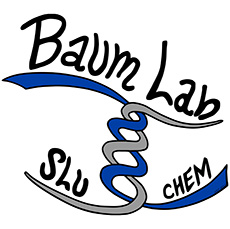 Isolation of DNA Aptamers That Bind Agarose Gel
Isolation of DNA Aptamers That Bind Agarose Gel
Emily Falk
This study employs SELEX to isolate DNA aptamers with a high affinity for agarose. Agarose's gel-forming ability makes it valuable for drug delivery and molecular immobilization, yet its utilization without chemical modifications remains a challenge. A randomized single-stranded DNA pool is introduced to agarose gel plugs under varied binding conditions. Unbound oligonucleotides are washed away, followed by recovery, then PCR amplification of the binding sequences. The resulting aptamers demonstrate enhanced binding activity, and the isolated aptamers are reintroduced into the agarose gel plugs. Each round of SELEX enriches the pool of aptamers for those with a higher affinity for agarose. Once the desired binding activity is achieved, the aptamer pools will be further characterized to understand their specificity, affinity, and potential applications. Agarose-binding aptamers promise diverse applications in biotechnology and medicine specifically in the delivery and release of therapeutic biomolecules.
Exhibit #35
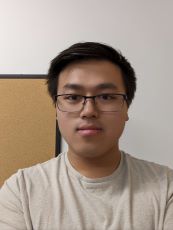 Lead (II) carbonate-alginate nanocomposite materials as contrast agents for fine vascular
MicroCT imaging
Lead (II) carbonate-alginate nanocomposite materials as contrast agents for fine vascular
MicroCT imaging
Kyan Ho
My research focuses on the synthesis of an improved nanoparticle-containing composite gel for imaging the fine vasculature of biological systems using X-ray techniques. The composite is composed of nanoparticles containing a lead carbonate phase (LNPs) distributed in an alginate hydrogel to produce a nanocomposite that gels after perfusion into the fine vasculature. LNPs are produced by an arrested precipitation process with capping provided by tetraethylene glycol, which controls nanocrystal growth and confers water dispersibility to the system. The LNPs have controllable X-ray contrast by variation of their concentration within the composite structure. Preliminary data and testing using X-ray and micro-CT imaging demonstrates that the LNPs have excellent X-ray contrast comparable to or greater than that of bone. The characteristics of the developed nanocomposite gel were shown to be improved over that of commercially available Microfil and a previously reported barium sulfate nanocomposite with a similar structure.
Exhibit #34
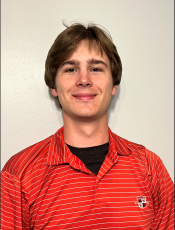 Manual and automated chemical synthesis of protected gentiobiose.
Manual and automated chemical synthesis of protected gentiobiose.
Kevin burke
All glycans, both natural and synthetic, are connected via O-glycosidic linkages,
but
synthesizing these linkages by chemical methods remains challenging. Many methods
for
chemical glycosylation have been introduced, but the complexity of the glycosylation
reaction
demands further improvement (1). Reported herein is the synthesis of differently protected
disaccharides. The conventional manual synthesis was then converted to the fully automated
synthetic platform that is being developed in our laboratory. The automated approach
helps to eliminate errors and improve reproducibility. Upon proper optimization of
the reaction conditions, we achieved fully automated synthesis and purification of
the target compounds
Exhibit #33
 Phenothiazine Synthesis Through Electrochemical and Photochemical Decarboxylative
Radical Coupling Reaction Development
Phenothiazine Synthesis Through Electrochemical and Photochemical Decarboxylative
Radical Coupling Reaction Development
Travis LaPonsie
Phenothiazine-based compounds are of interest in medicinal chemistry as both antifungals and for treating mental disorders. However, in some instances generating the phenothiazine core has proven difficult, with current synthetic pathways proving unreliable or not reproducible. Developing new and efficient reactions for phenothiazine generation could allow for synthesis of a wider variety of phenothiazine cores. The goals of this research project are to expand upon the traditional reaction schemes aimed at generating phenothiazines with the addition of either electrochemistry or photochemistry. This work explores routes to C-N bond formation to form phenothiazines via two methods. One direction involves the use of electrochemistry to assist catalyst turnover in poor-yielding Buchwald couplings. The other is the use of photochemistry and copper catalysis to induce decarboxylative C-N bond formation, a route that has not been explored in phenothiazine synthesis to date.
Exhibit #32
 Reactive Metal Nanoparticles for H2 Gas Generation and Solid-state Propellants
Reactive Metal Nanoparticles for H2 Gas Generation and Solid-state Propellants
Steven Buckner, Paul Jelliss, Elisabeth Johnston, Mohammad Kader, Calvin Nyapete, Gowtham Reddy, Maxwell Gao
Production of high energy density materials is an important research area with applications in many areas such as energy storage and delivery, chemical processing, and propellants. Reactive metal nanoparticles (RMNPs) are particularly useful as high energy density systems but reactivity challenges arise due to their inherent instability. We present two methods for the stabilization of RMNPs for specific applications in hydrogen production and in solid-state propellants. RMNPs were successfully passivated within the pores of metal organic frameworks (MOFs) and by capping with polyethylene. We hereby present results for RMNPs@MOF composites as hydrogen generators and polyethylene-capped RMNPs (PEN particles) as a rocket propellant material.
Exhibit #31
 Structure activity relationships of core replacements in a phosphodiesterase inhibitor
for the treatment of cryptosporidiosis
Structure activity relationships of core replacements in a phosphodiesterase inhibitor
for the treatment of cryptosporidiosis
Caroline Christ
Cryptosporidiosis is a diarrheal disease caused by the parasites C. parvum and C. hominis which can be life-threatening for children and immunocompromised patients. The only currently approved treatment for cryptosporidiosis, nitazoxanide, is only moderately effective in children and not effective in patients with immunodeficiencies. This study explores the role of core structure in the potency of a series of phosphodiesterase inhibitors in the Cryptosporidium parasites. By changing the heterocyclic core structure of the lead compound (“core-hopping”), the structure activity relationship can be determined and used to optimize the structure of the potential drug molecule. Inhibition of the Cryptosporidium parasites by the synthesized analogs indicates that the pyrazole core structure in lead compound SLU-2815 may not be essential for activity and could be equally or more efficacious with an alternate core.
Exhibit #30
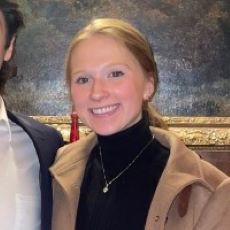 Synthesis and SAR Studies of the 3-position of SLU-10482 for the Identification of
Novel Anti-Cryptosporidium Drug Analogues
Synthesis and SAR Studies of the 3-position of SLU-10482 for the Identification of
Novel Anti-Cryptosporidium Drug Analogues
Caitlin Hamill
Cryptosporidiosis is a leading waterborne infection caused by the Cryptosporidium parasite that causes diarrhea, dehydration, and malnutrition. In severe cases, the parasitic infection can result in death, most notably in young children and immunocompromised patients. Nitazoxanide is the only FDA-approved treatment, but is only modestly effective, suggesting a critical need for a new anti-Cryptosporidium drug that effectively treats all patient populations. Previous work identified triazolopyridazine MMV665917 as an analogue, which has an EC50 of 2.1 µM. This finding led to the synthesis of SLU-10482, an analogue with an improved EC50 of 0.070 µM. The current work seeks to replace the 3-trifluoromethyl group on SLU-10482 and develop structure-activity relationships (SAR) in that position. Twenty-six novel analogues were synthesized and evaluated for potency against Cryptosporidiosis, with the most potent replacement to date being the propylene SLU-11358 analogue (EC50 = 0.56 µM).
Exhibit #29
 Synthesis of a Novel Macromolecular Drug Delivery System Based on Cyclic Galactose
Synthesis of a Novel Macromolecular Drug Delivery System Based on Cyclic Galactose
Alexei Demchenko, Daniel Hoard, Anastasiia Vinogradskaia
Recent studies have shown that cyclodextrins (CD), cyclic oligosaccharides composed of linked glucose units, exhibit anti-inflammatory activity. CD possesses a hydrophobic inner cavity capable of encapsulating cancer drugs, while their hydrophilic surface increases the drug’s solubility. However, while CDs show an increase in stability, solubility, and reduced toxicity, they still have limited therapeutic effects and can cause complications. The current goal in drug delivery system development is to efficiently deliver drugs to their target binding sites, protecting them from degradation and digestion, enhancing pharmacokinetics, and enabling the crossing of biological membranes without disruption. In this study, we present a new approach for the synthesis of cyclogalactin, a cyclic carbohydrate structure containing galactose units that shows promise for pharmaceutical applications. It possesses a similar structure to CD, but its hydrophobic site significantly extends. Currently, attempts to synthesize cyclogalactin have been unsuccessful. Reported herein is our attempt to create a 6-membered galactose.
Exhibit #18
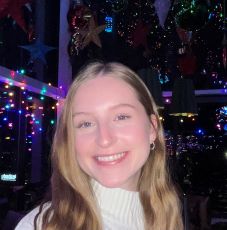
Synthesis of Novel Efflux Pump Inhibitors in the Multidrug Resistant Acinetobacter baumannii
Makaila Leask
Acinetobacter baumannii is a multidrug resistant bacterium that is largely associated with hospital-acquired infections. Multidrug efflux pumps, belonging to the Resistance-Nodulation-Division (RND) superfamily, are the major mechanisms that contribute to antibiotic resistance in bacteria. The RND pumps AdeABC and AdeIJK are the efflux pumps of interest that are responsible for the drug resistance in A. baumannii. The development of efflux pump inhibitors for A. baumannii will allow for the potentiation of antibiotics. In this research, analogs of 4,6-diaminoquoniline and benzamidines had inhibitory activity against A. baumannii efflux pumps. The best analogs had target specificity, inhibited AdeIJK efflux, and potentiated antibiotics erythromycin and novobiocin.
Exhibit #17
 Gateway South Community Center
Gateway South Community Center
Jake Cullotta, Mikayla Elkins, Brooke Kenworthy, Steven Lum, Olivia Sotelo
H3 Engineering is developing the Gateway South Community Center, a steel structure designed to serve as a vibrant hub for physical fitness, community engagement, economic growth, and collaborative endeavors. Situated with convenient access to I-44 and the waterfront, the center offers a view of the Gateway Arch. By integrating a full-service gym, versatile retail spaces, and communal workspaces, Gateway South aims to be the neighborhood's centerpiece, providing diverse opportunities for residents to thrive and connect. The project reflects a deep understanding of community needs, offering not just a gym but a multifaceted space that promotes holistic well-being. The center features state-of-the-art facilities for cardio, strength training, yoga, group fitness classes, rock climbing, and indoor pickleball. Additionally, it provides flexible community workspaces that encourage collaboration, innovation, and creativity, catering to intellectual and professional growth.
Exhibit #14
 Gateway South Manufacturing Training Facility
Gateway South Manufacturing Training Facility
Carly Sear, Nick Tomecek, Mariandrea Miranda, Owen Uyemura
Saint Louis Building Company is designing a Manufacturing Training Facility in the Gateway South Development, south of the Arch. One purpose of the Gateway South Development is to attract construction and manufacturing companies. The purpose of the manufacturing training facility is to train future employees of these companies.
The Manufacturing Training Center is 30,000 sqft. building designed with the goal to reach a Gold LEED rating. With over 20,000 sqft. of training space, 5,000 sqft. of office and classroom space, there is plenty of room to accommodate the needs of the companies moving to the Gateway South Development.
Saint Louis Building Company is providing a comprehensive design of all aspects of the site including: the structural design of the training facility, civil site design for the approximately 3.5 acre site, a LEED analysis to ensure that a Gold LEED rating is achieved, and more.
Exhibit #3
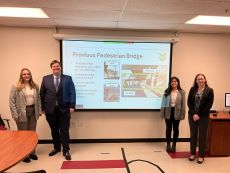 I-64 S Spring Pedestrian & Bicycle Bridge
I-64 S Spring Pedestrian & Bicycle Bridge
Laura Gray, Maddy Kieffer, Jack Tapy, Morgan Voissem
Gravity Solutions presents a solution to bridge the gap between midtown St. Louis attractions. The "I-64 S Spring Pedestrian & Bicycle Bridge" will serve as a connection between two expanding social centers—the City Foundry STL and the Armory STL—as well as the Saint Louis University community. While these attractions are less than 200 feet apart, they are divided by the dual-level Interstate Highway I-64, thus making access between the two difficult and inconvenient. This project seeks to implement a pedestrian and bicycle crossing that will pass between the upper and lower levels of I-64 with accessible landings by the City Foundry STL and Armory STL to promote multimodal accessibility to both features.
Exhibit #2
 Agrarium
Agrarium
Ryan Lamping, Grace Lin, Ana Belen Ortiz (Madrid Campus)
Agrarium is a start-up multi-vendor digital marketplace for the purchase and sale of premium agricultural products, focused primarily in Ecuador. Our aim is to convert an already existing, complex and offline process into one that is simple, reliable and online. The goal for Agrarium is to create a fluid and fair market for agricultural products, elevate supplier and customer satisfaction, establishing a more authentic, fair, and dependable marketplace. We also aim to advocate for fair trade by eliminating intermediaries with unfair pricing, promoting transparency and ensuring higher-quality agricultural products. Through a transparent marketplace, we aspire to create a system that allows farmers to receive the true value of their products, and thus, promoting the production of higher-quality agriculture products as well. When farmers are supported, the entire food supply chain benefits.
 Bubble Scan
Bubble Scan
Ahmet Ali Yildiz, Nischita Nannapaneni, Myles Correa
Cheminstry department at SLU uses paper scantron (fill in the bubble) sheets for exams. To grade the exams, they physically take the papers to one of the two machines on campus capable of processing this data. This process is time consuming and a bit risky - the machines are getting old and might break. In general, they like useing paper based fill in the bubble exams, but are interested in digitizing the grading process through software that presents them with detailed results, similar to the results they get from the physical scantron machines. The specific sheets used by the chemistry department are Scantron form number 95945. While not hugely expesive, not having to order such sheets is a cost saving. Most importantly, this software would replace the technology that's becoming obsolete and simplify the grading process.
Exhibit #48
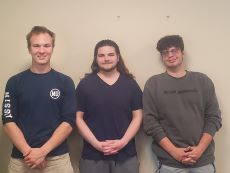
Database of Arithmetical Dynamical Systems
Andrew Jelliss, Evan Richmond, Louis Rowles
The Database of Arithmetical Dynamical Systems is a research tool for a subset of mathematics that is implicated in almost every major scientific field. This project provides an easy to use interface for accessing a database of precomputed values for each dynamical system entry that would otherwise take significant time to compute. The interface allows users to employ several filters to begin exploring results and making connections between systems much faster than common mathematical software typically allows.
Exhibit #64
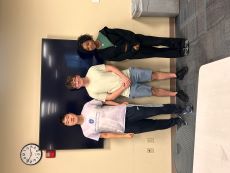 DroneWorld
DroneWorld
Kaleb Yu, Hebron Bekele, Simon Rostkowski
DroneWorld is a platform for simulated UAV testing. The application allows users to input specific requirements, such as environment conditions, sUAS capabilities (sensors, hardware), and more test properties.It generates a realistic 3D simulation environment using digital shadow models and runs the user's sUAS application within it. DroneWorld monitors and collects data to check if safety properties are violated. DroneWorld analyzes the simulation results and generates test reports. DroneWorld lets you thoroughly test drone applications in highly realistic simulated settings before actual flights. This helps enhance safety and reliability. By automating testing in simulations based on specific requirements, the application enables drone developers to work more efficiently, iterate quickly, and create strong systems for challenging missions.
Exhibit #28
 ESP - Electronic Structure Parser
ESP - Electronic Structure Parser
Medhani Kalal, Hayden Karl
ESP is an open-source quantum chemistry software package that can simulate molecular properties using quantum mechanical calculations. It is a web application that allows users to select their desired text file containing information regarding quantum chemistry software data. Then select the required fields from a multi-select dropdown that is provided on UI. After conversion, the user can download the file in .docx format, which contains the desired output. By using the ESP, researchers can easily share data with collaborators who use different quantum chemistry software.
Exhibit #49
Gallery of Glosses
Kameron Bustos, Bradley Leesman, Tu Tran
The Gallery of Glosses is an open-access digital platform devoted to revealing the richness of the medieval era through a meticulous study and interpretation of glosses from 12th-century manuscripts. Our mission is to bridge the gap between past and present, connecting today's scholars, students, and enthusiasts with the scholars of the medieval era whose voices have been 'lost to the margins for centuries'.We provide an immersive experience that allows students to engage directly with historical texts, fostering the development of translation and transcription skills, and offer educators a wealth of source material for their courses.
Exhibit #50
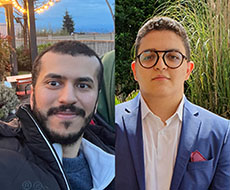 Gas Station Management System
Gas Station Management System
Mohamed Azizi, Mehdi Housni (Madrid Campus)
An all in one tool to facilitate the operations of gas station management with comprehensive features to track, upload earnings and expenses, handle human resources and supervise multiple locations.
Exhibit #51
 Homeless Shelter Volunteer Scheduling Application
Homeless Shelter Volunteer Scheduling Application
Chloe Biddle, Ngoc Yen Nhi Tran, Akhil Vemulapally
This website connects with the GetHelp platform, which provides a centralized website to view shelters availability and information efficiently. Currently, there is not a good volunteering system in place, so we are working to enable shelters and their volunteers with an easier volunteer scheduling platform. This will give real time information for each shelter using GetHelp on how many other volunteers are scheduled at specific times. The volunteers will also be able to login to the website and view their current and past shifts, as well as sign up for new ones and cancel ones they have already scheduled. We developed the website using React, and we are utilizing the GetHelp API to connect with nearby shelters.
Exhibit #63
MeltShiny
Zohaib Ahmed, Massimo Evelti, Ethan Gray
MeltShiny is a software application that automates the analysis and visualization of DNA melting curves for researchers in chemistry, biology, and genetics. It is built on tools like MeltWin and MeltR, resulting an intuitive graphical user interface with robust data processing capabilities powered by R. MeltShiny removes the need for manual curve fitting with just a few clicks, researchers can upload their DNA melting data and automatically generate graphs and tables. Key benefits include automated outlier removal, compatibility with modern operating systems, and accessibility for non-programmers. By streamlining tedious tasks like handling file formats and filtering data, MeltShiny allows researchers to focus their time on scientific analysis and interpretation. Its simple yet powerful interface makes complex computational analysis of DNA thermodynamics accessible to scientists with varied technical skill levels.
Exhibit #52
 Mouser
Mouser
Ryan Carmody, Andrew Obermiller, Stanley Yang
Working with Dr. Karoly Toth of the Saint Louis University Medical Research Department to develop an easy to use and efficient software to track hamster weights during research trials. The program itself is a recreation of Dr. Toth's original program written in 1997 using the language Basic. Our aim is to retain the functionality of the original program while using the current technological advancements and incorporating new features impossible at the time of its creation. The program works to limit researchers from touching input devices while handling Hamsters in the trial to prevent cross contamination.
Exhibit #53
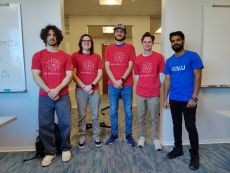 Pi4Micronaut
Pi4Micronaut
Alex Delgado, Joe Folen, Adrian Swindle, John Yanev
Pi4Micronaut is an innovative Java library crafted for developers who aim to build Internet of Things (IoT) applications leveraging the Raspberry Pi platform. This software is designed to run directly on the Raspberry Pi, providing an interface between the high-level Micronaut framework and the low-level hardware control provided by Pi4J. It serves as a vital tool for Java developers who wish to create sophisticated IoT solutions that interact with various sensors and electronic components. By abstracting the complexity of hardware interactions, Pi4Micronaut allows developers to focus on crafting business logic and features, making it easier to bring IoT applications from concept to deployment rapidly.
Exhibit #54
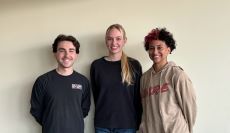 Rerum Geolocator & Navplace Viewer
Rerum Geolocator & Navplace Viewer
Emily Henken, Kyla McMakin, Tony Obradovic
The application enables users to enhance discovery and access to digital resources through geographic visualization and annotation. Users can bring in their own resources and generate Geolocating Web Annotations for them. These structured annotations contain geographic coordinates and other spatial/temporal metadata using the Web Annotation data model. This enables accurate placement of the resources onto a web map. The application also supports adding a navPlace property to IIIF Defined Types. The International Image Interoperability Framework (IIIF) provides a standard way of describing and delivering digital resources. The IIIF Defined Types with the navPlace property can be imported into the RERUM platform, this provides a map-based visualization that enables exploring, discovering and connecting resources through their geographic metadata. The Navplace Viewer allows new insights and connections by leveraging the spatial relationships between resources.
Exhibit #61
--
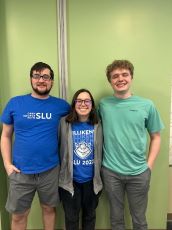 Seeing Is Believing
Seeing Is Believing
Anna Kidwell, Miles Monday, Owen Thomasson
Seeing Is Believing is a web-based educational learning tool that facilitates teacher and student dialog to reinforce proper pronunciation when learning a secondary language. Students can observe their improvement through a compilation of spectrograms that compare their pronunciations with native and non-native speakers' pronunciations. Teachers are able to assign words for students to practice. Once students submit their work, teachers are able to grade student submissions and give feedback.
Exhibit #56
 SoundTrack for Spotify
SoundTrack for Spotify
Claudio Catalano Leiva, Francisco Vanrell, Jaira Vazquez Sanchez (Madrid Campus)
SoundTrack for Spotify is a mobile application designed to enhance the daily journaling experience for users on all platforms. The main objective of SoundTrack for Spotify is to provide users with a journaling tool and to enhance their Spotify listening experience through a set of user account information and musical recommendations based on the user’s mood and musical preferences. SoundTrack for Spotify allows users to write daily journal entries including a Spotify song and their daily mood, as well as information about their daily activities. Through these entries, users will be able to look back on previous experiences, analyze their mood patterns, and discover new music based on their taste profile and moods.
Exhibit #57
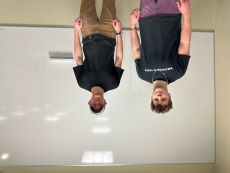 SpeechTranscription
SpeechTranscription
Colin Bush, Travis Herrick, Jack Pifer
We are working on a speech pathology transcription application. Our software transcribes a patient and instructors dialogue to text. Our software contains features that can detect different grammatical and other speech issues with the patients speech. This serves to save the instructor a lot of time and energy as they no longer have to manually transcribe the patients dialogue.
Exhibit #58
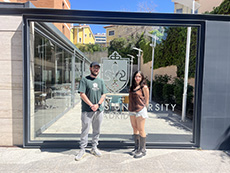 TechProp.ai
TechProp.ai
Joe Farah, Samia Mahdaoui (Madrid Campus)
TechProp.ai envisions the development of an innovative digital tool in the form of a website. The primary purpose of this tool is to leverage the precision and speed of AI (Artificial Intelligence) algorithms to conduct comprehensive analyses of the ever-evolving real estate market. The main objective of the Real Estate Market Analysis Tool is to provide real estate professionals, investors, and brokers with a powerful resource that automates the analysis of real estate market data. This website can also be used by regular people who want to check a price estimation for properties they desire to put on the market.
Exhibit #59
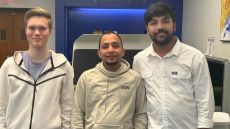
TPEN Services
Bhanu Prasad Kandula, Leandru Martin, Sandeep Kumar Sutharapu
TPEN 3.0 is revolutionizing scholarly transcription with a user-friendly platform designed for scholars studying medieval and classical texts. Our upgraded platform features a powerful self-contained API, facilitating seamless user group management, project configuration, and transcription annotation creation. Authenticated users can leverage this API to process HTTP requests, with data stored in MongoDB documents in a cloud collection and public data repository. The system also supports the creation of compliant Web Annotations and IIIF documents, housed in the RERUM public data repository. Open web endpoints enable users to access standardize
d project versions, transcription layers, and annotations in JSON format. With a focus on accessibility and reliability, TPEN 3.0 empowers scholars globally by simplifying the transcription process and enhancing collaboration without requiring technical expertise.
Exhibit #60
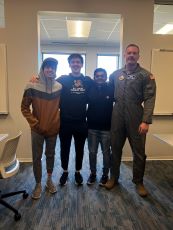
Where's Religion (Desktop)
Josh Hogan, Izak Robles, Stuart Ray
Where’s Religion? is an open-source mobile and desktop web application developed by humanities faculty and IT professionals at Saint Louis University that supports in-person research, remote data entry, media sharing, and mapping. To do this, the mobile app enables users to collect fieldnotes, image, video, and audio files – all of which are geotagged and timestamped. The desktop companion website/app provides a more feature-rich format to refine fieldnotes, edit media, make new entries, or, for certain user profiles, review or grade other users’ entries. When published, entries are automatically curated online within an interactive public map that has search and filter functions for enhanced usability. Where’s Religion? is conceptualized and designed for students, researchers, and public users to document and share their encounters with “religion” in everyday life – all with the intended purpose of democratizing data collection and visualizing religious and cultural diversity at scale.
Exhibit #62

Where's Religion (Mobile)
Tom Irvine, Andrew Chen, Sophia Bahru, Yash Kamal Bhatia
Where's Religion Mobile aims to consolidate the tools of a cultural anthropologist into your phone and allow people to post and share about their encounters and experiences in a streamlined and easy to use environment.
Exhibit #47
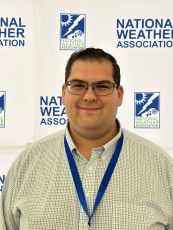 Probabilistic Problem: Incorporating Feedback from Emergency Managers to Improve Probabilistic
Forecast Messaging
Probabilistic Problem: Incorporating Feedback from Emergency Managers to Improve Probabilistic
Forecast Messaging
Jack Rotter
Probabilistic forecasting is the future of forecasting from the National Oceanic and Atmospheric Administration’s (NOAA’s) National Weather Service (NWS). Rather than providing a deterministic forecast to emergency managers and local decision makers, probabilistic forecasts use basic statistics to lay out a variety of possible scenarios. In addition to providing multiple scenarios, there is also more room for error in emergency managers’ interpretation of these forecasts. Working with NWS Fort Worth forecaster, Madi Gordon, the interpretation of graphical probabilistic forecasts by emergency managers was studied and best practices were developed for the NWS Fort Worth office. After establishing best practices at the local level, further research is being conducted at the national level with the intent of gaining further understanding of any biases emergency managers have across the United States. This, in turn, will lead to guidelines to improve graphical probabilistic forecast messaging across all NWS forecast offices.
Exhibit #16
 Using Supervised Machine Learning and HYSPLIT Backwards Trajectories to Predict Airborne
VOC Concentrations
Using Supervised Machine Learning and HYSPLIT Backwards Trajectories to Predict Airborne
VOC Concentrations
Victor Geiser
It is known that Volatile Organic Compounds (VOCs) in the atmosphere have harmful and adverse effects on human health. Recent literature suggests some VOCs may also have an effect on global radiative forcing, despite making up a very small fraction of the total atmospheric composition. Due to this, making accurate predictions of these concentrations within the context of the dynamic atmosphere is both a challenging yet imperative problem. While the fields of atmospheric chemistry and meteorology are often addressed in adjacent but related contexts, this study looks to examine the importance of meteorological variables on the concentrations of these VOCs at parts per trillion level precision, based on fully open-source meteorological data alone. Through this study it was found that although considering meteorology data alone is not enough to predict these concentrations, meteorological variables such as potential temperature, solar radiation, and mixing depth appear to have elevated importance across a standard array of meteorological variables. Moreover, this study proves that additional considerations are necessary to address the differences in data types of whole air sampling data and meteorology data when incorporated into machine learning workflows. The results of this study show that it is possible to predict airborne VOC concentrations using meteorological variables, but the accuracy of these results is currently limited by discrepancies between the spatial resolution of meteorology data and the discrete nature of whole air samples. However, given that these structural challenges exist, applying modern techniques in imbalanced regression may help address these challenges.
Exhibit #1
 Preparation of High Quality Few Layer Graphene Coated Metal Alloys for Medical Applications
Preparation of High Quality Few Layer Graphene Coated Metal Alloys for Medical Applications
Abigail Roe, Zijun Wang
Graphene, a single or few layer carbon film, has been shown to have antimicrobacterial and antibacterial properties, with excellent thermal and electrical conductivity that allows for the material to be used in medical devices and implants. Here we explore direct growth of high-quality, few layered graphene on metal alloy substrates using chemical vapor deposition (CVD) and characterize its structural integrity. CVD is a scalable and controlled method of synthesis, often used in industry for large scale applications. By using CVD synthesis on FDA approved metal alloys, we can study the morphology and structural characteristics of graphene samples to investigate the most optimal growth conditions for high quality graphene with strong adhesion to its host substrate. We also discuss the design and construction of an additional smaller scale CVD system which will be dedicated predominately to high quality carbon materials growth, such as graphene and carbon nanotubes, for medically relevant applications.
Exhibit #15
2023 Student Projects
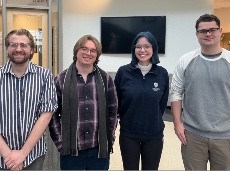 Air-Carrier Fatigue Mitigation Strategies
Air-Carrier Fatigue Mitigation Strategies
Ashleigh Bick-Dawes, Jacob Flowers, Tyler Lambert, Michael O'Donnell
Our project seeks to identify and examine air-carrier fatigue mitigation strategies and the effects of sleep quality and sleep deprivation. We want to examine the current sleeping conditions of the crew and how to best improve these conditions for the future. We're reviewing relevant documents and surveys to best tell a story on how the risk associated with fatigue can be decreased in aviation.
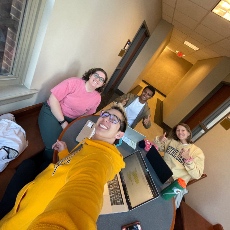 Culture in the Cockpit
Culture in the Cockpit
Akio Hansen, Hannah Nodge, Curtis Scott, Ashley Storz
Our project will showcase the influences of culture and diversity that interact in an aviation context. We will focus on these impacts specifically within the cockpit and how all of these aspects come together to create various dynamic teams and scenarios. We discovered that culture has an impact on safety as seen through our various lenses of research. Overall, we have seen how culture and diversity shape the cockpit in regard to safety and teamwork.
 Environmental Impacts of Aviation: Aircraft Design
Environmental Impacts of Aviation: Aircraft Design
Jerry Cockrum, Angie Lowell, Sisheng Ma, Nathan Seliner
The goal of our project is to find the most impactful ways through aircraft design to reduce aircraft emissions and improve fuel efficiency. By looking at many different types of aircraft, performance characteristics, and manufacturers, we found that a combination of varying aircraft design improvements is necessary to lowering emissions overall. From the widespread implementation of turbofan engines to switching to advanced composite materials and laminar flow airfoils, there are several key factors of aircraft design that can work together to help our industry achieve carbon-neutral growth.
 Ground Infrastructure Considerations for Alternative-Energy Aircraft
Ground Infrastructure Considerations for Alternative-Energy Aircraft
Sam Byrne, Eric Deles, Kyle Kaestner, Marike Kobepa, Joseph Mason
Multiple air carriers and aircraft manufacturers are exploring alternative energy sources to meet carbon reduction targets. As there are multiple competing technologies, it is as of yet unclear which technologies will be adopted as the standard, and what the ground infrastructure requirements for these aircraft will be. This paper will explore what steps airports of various sizes might need to take in order to accommodate these new alternative-power aircraft.
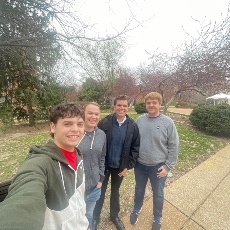 Is the TSA an Illusion of Safety?
Is the TSA an Illusion of Safety?
Stephen Lindberg, Nick Bohn, Adam Shelton, Andrew Sinelli
We are comparing data between the effectiveness of the TSA’s security to other security administrations in other countries.
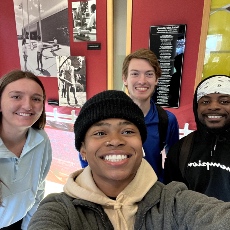 Mental Health in the Aviation Industry
Mental Health in the Aviation Industry
Marisa Warren, Chris Moll, Alma Karabas, Ijah Morgan
Our project will be regarding the discussion of mental health of aviation professionals. We will gather information from reliable sources to observe a rough idea of the mental state of aviation professionals. We will also look at the resources that are provided to enhance the quality of life for employees. Finally, we make a critical evaluation of how airline companies can improve, or continue to provide good resources.
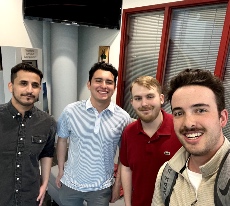 Mitigating Stress in the Cockpit
Mitigating Stress in the Cockpit
Salem Alotaibi, David, Barajas, Zachary Carlson, Michael Place
Pilots are tasked to evaluate their physical and mental wellness before conducting a flight by utilizing the IM SAFE Checklist. The checklist asks pilots to evaluate their stress levels and determine whether or not they pose a safety risk to fly their aircraft. If stress poses a danger to a pilot and their operation, what are ways that pilots can mitigate their stress in order to safely fly, and are they effective? Our group researched how different stressors affect pilots in a multitude of aeronautical situations. We then examined the different ways pilots mitigate these stressors and referenced studies to determine if these mitigation strategies worked in reducing stress.
Runway Capacity in the U.S.: Current vs. Forecasted Needs
Fares Alenzi, Mohamed Almajid, Christian Henkel, Devin Henneberry, Chase Meyer
There aren’t enough runways to meet the growing concentration and demand of airline
travel in the US. Three reasons for this are: environmental concerns to building runways,
funding/resource issues to expanding airports/runways, and difficulties of acquiring
land to expand airports/runways. These issues are somewhat unique to the US in comparison
to other countries with more centralized government oversight and control. This paper
will ascertain that the current capacity of airports/runways will not be able to meet
growing demand, and it will examine these three primary roadblocks to expanding airport
infrastructure — specifically runways.
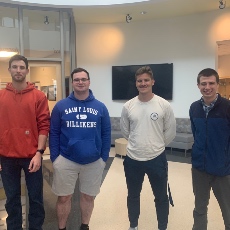 Socioeconomic Boundaries of Becoming a Pilot
Socioeconomic Boundaries of Becoming a Pilot
Xander Jones, Jamison McCarty, Al Schulz, Holden Strickland-Amico
Our project focuses on the socioeconomic boundaries preventing those aspiring to become a pilot. Currently, the aviation industry is predominantly made up of white male students. Our project dives into boundaries preventing those who want to become a pilot. This may include financial, interest, and understanding of the pathway forward.
 The Feasibility of Lowering Hiring Minimums in the United States: A Comparative Analysis
The Feasibility of Lowering Hiring Minimums in the United States: A Comparative Analysis
Logan Hine, Ahmed Lingga, Mince Mbisikmbo, Patrick Waterman
What effect would changing hiring minimums in the United States have on flight training and CFI’s? We want to look at hiring minimum data from other countries as they apply to airline jobs as well as private jet jobs to evaluate whether or not that has a large effect on CFI’s or flight training in general. We will evaluate how America has changed since hours went up and we hope to predict what would happen if hiring minimums (for airlines and charter jobs) were to be lowered.
Assessing Anemia in Resource-Poor Regions
Amogh Chariyaman, Andrew Kotz, Jake Little, Kevin Noonan
There exists a need within developing regions to quantify hematocrit reproducibly and accurately. Through lab testing, a distinct linear regression has been determined between the decent time of sampled blood in a solution of copper sulfate and hemoglobin/hematocrit concentration. Said correlation provides the basis for quantifiable test results which do not exist with current low-cost methods. Future work focuses on automizing the testing processes through infrared-photogate timing and data reduction algorithms. Ultimately, the project aims to implement the automized low-cost testing method in conjunction with Randolph Ministries in Haiti.
FREQSAT (Frequency Response Earthquake Satellite Constellation)
Ford Frazer; Cullen Leming; Blake Peftoulidis; Nicole Russ; Shane Todd
FREQSAT (Frequency Response Earthquake Detection Satellite Constellation) is a 3U-CubeSat constellation mission to detect Extremely Low Frequency (ELF) radiation as a means of detecting major earthquakes and transmitting data to the ground network efficiently. Based on QUAKESAT, a decommissioned single CubeSat mission from Stanford University back in 2003, FREQSAT aims to function as an innovative product that can expedite disaster relief methods and directly impact communities that may be affected by recurring earthquakes. The Low-Earth Orbit (LEO) mission will consist of 16 3U CubeSats and will operate in one of three projected orbit paths centered on earthquake hotspots in North America, East Asia, and the Middle East. FREQSAT boasts an effective COMMS network where there is streamlined communication both to and from the ground network and between each spacecraft. This product aims to be utilized by a myriad of governments and disaster relief organizations across the globe.
 Ice Melt Express
Ice Melt Express
Maddie DeClue, Emma Kallianis, Payton Loftis, Jack Ross, Antoine Traboulsi
The aim of this project is to design a sidewalk ice melt spreader targeting home and small business owners in urban areas with a climate where icy sidewalks and low temperatures are prevalent. The Ice Melt Express is a remote-controlled salt dispensing robot that allows home and small business owners to easily de-ice their sidewalks and walkways. Unlike push salt spreaders and other current solutions, the Ice Melt Express allows the user to deice their sidewalks without having to step out into the cold weather. The device is battery-powered and features an aluminum frame, an independently powered broadcast spreader, two driven pneumatic wheels, a castering pneumatic balance wheel, and a 30-pound agitated hopper.
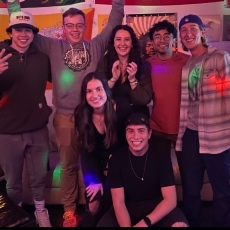 LEBEAU Mission
LEBEAU Mission
Griffin Goss, Juanita Latorre Jaramillo, Julia Maxwell, Louis Meyer, Mateo Salazar, Eduardo Teixeira, Jackson Woodside-Miller
The Long Endurance Buoyant Environment and Atmosphere of Uranus (LEBEAU) mission aims to provide important insights into the development of our solar system, features of ice giants, and our general knowledge of exoplanets. For this reason, a new flagship mission is being proposed to send three probes to Uranus to study its atmosphere. The three probes will be equipped with state-of-the-art scientific instruments designed to measure the composition of the atmosphere. Such measurements include but are not limited to temperature, pressure, and chemical composition. The orbit vehicle, which will carry the probes from Earth to Uranus, will gather data on the planet's magnetic field, radiation environment, and large-scale meteorological events, which will help to provide a better understanding of the overall dynamics of the Uranian system.
 M.E.A. (Mars Exploratory Aircraft)
M.E.A. (Mars Exploratory Aircraft)
Chems Eddine Boudiaf, Alejandro Calleja Bezares, Atef El Nakib, Luis Andrés Mariño, Jorge Martín de Valmaseda, Ainhoa Muñiz Quintana
M.E.A (Mars Exploratory Aircraft) is a research study focused on developing the design of an aircraft that will ultimately be able to fulfill missions on the environment of Mars, in which it will travel 100km to a chosen area in which it will loiter to take necessary data with the onboard sensors and will return to the base. With the assumption of established human presence and the disposal of suitable terrain for taking off and landing on the Red Planet, the purpose of M.E.A is to facilitate the discovery of new terrains that might be of interest to scientists by sweeping large areas in short periods of time. Why choose M.E.A. when Rovers and a helicopter have already been on Mars? NASA’s Ingenuity helicopter and Perseverance Rover, although being milestones in the exploration of Mars, could easily be replaced by an astronaut, it‘s important to note that neither of them has the capabilities of M.E.A. which will be able to fly hundreds of kilometers in several directions at once which will ultimately be more efficient and safer than any other exploratory method previously used.
 O-Bubble
O-Bubble
Ketura Bates, Jesed Diaz, Silvia Lockhart, Michael Joseph, Nguyen Truong
As drone flights become more sophisticated technology keeps evolving. There is a need
for equipment to be more reliable, less prone to failure, and have a satisfactory
level of stealth. The consumer is in search of a drone with minimum to no noise, suitable
for places that require minimum distractions. O-Bubble aims towards these desirable
features mentioned above. The innovative characteristics of this drone are ultra-light,
focused on recording silent indoor events, capable of running on 60dB flight sound
in a 1ft distance, and an excellent recording time of 1 hour.
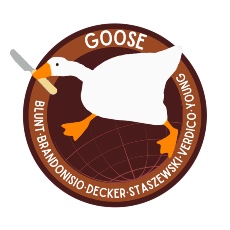 Project Goose
Project Goose
Michael Blunt, Pasquale Brandonisio, Jordan Decker, Aaron Staszewski, Daniel Verdico, Benjamin Young
The mission of Project Goose is to design, build, and fly a small Unmanned Aerial Vehicle to be used for Intelligence, Surveillance, Reconnaissance, and Light Attack roles. Goose is tasked with taking off from a 50-foot runway, cruise for 7.5 nautical miles, deploy a release glider containing a 2.5-pound payload which is then guided to its target, while the primary aircraft returns to land on a 100-foot runway. The payload Released Vehicle is a wing-only glider with a 2.4-foot span that is guided via a First Person View link to its target by a flight engineer while the primary aircraft is piloted by a second crew member. Additionally, the aircraft and its systems are to be assembled and airborne in under 10 minutes. To accomplish these mission parameters, the team designed and built an aircraft boasting an 8-foot wingspan and 15-pound Maximum Gross Takeoff Weight. The aircraft is capable of cruising at a speed of 40 knots for 25 minutes, providing a range of 15 nautical miles.
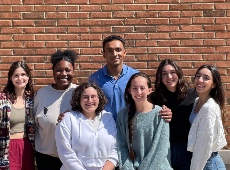 SANDY - The Beach Cleaning Device
SANDY - The Beach Cleaning Device
Hannah Bessmer, Michaela Godlewski, Sheridan Grant, Christiana Hietter, Vassiliki Karamouzi , Natalie Lassak, Shaun Samuel
The magnitude of pollution that we see on beaches today threatens the health of humans and the health of our planet. After thoroughly researching the issue and realizing its magnitude, The Girls & Co. have proposed a solution to the problem. This group of engineering students designed, modeled and built a device with the capability of effectively and efficiently collecting waste on beaches. It's a device they are calling SANDY. Important elements of SANDY showcase the group's environmental concerns such as the device being battery-powered and made of sustainable materials. The importance of a device like SANDY extends beyond the walls of McDonnell Douglas Hall and has huge benefits for our planet.
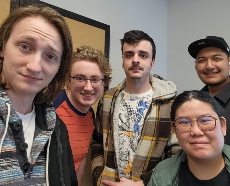 Sidewinder
Sidewinder
Alex Christian, Sean Maguson, Max Matura, Joshua Quezada, Sally Shim
The goal of the Snakecharmers is to create an inexpensive and accessible modification for a standard wheelchair, that provides motorization to a wheelchair that did not previously have it. The Sidewinder is an independent modification that is designed to be attached to many standard hospital wheelchairs, providing motorization controllable through both a joystick, and a cruise control system. The Sidewinder is designed to be affordable for those who cannot invest in fully motorized wheelchairs, but still want the convenience of powered wheelchairs.
SIRAAV
Stephen Hyndman, Eric James, Jeffrey Lewis
Design of a Search and identification vehicle(s) for natural disaster scenarios
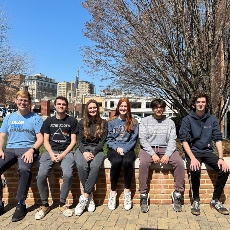 Solar Desalination
Solar Desalination
Charles Carroll, Grace Coleman, Anthony De Luca, Hayden Eckstein, Jaclyn Heigert, Joseph Preboy, Humza Siddiqui
A solar-powered water desalination system for communities with limited access to drinking water. Used solar panels to power a heating coil that boils water. The boiled water condenses on a glass panel and runs into a bucket for use.
 SprayBot
SprayBot
Reid Chunn, Eliot Ekindi, Ryan Evans, Elliott Guereca, Joel Kannath, Dylan Turner
The Spraybot is an automated solution to painting lines on sport fields and on other mediums. The Spraybot is designed to reduce manual labor, improve accuracy, decrease painting times, and reduce overall cost of marking by using a majority of off-the-shelf materials combined with proprietary programming to offer a low learning curve and high execution potential.
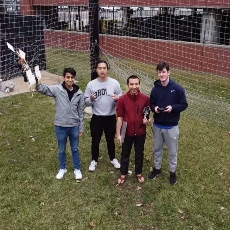 Team MOMO – Autonomous Glider Payload Delivery
Team MOMO – Autonomous Glider Payload Delivery
Marcus Klupar, Francisco Bueno, Michael He, Fauzan Hasanbasri
Team MOMO is doing a design, build and fly project. We are competing in the AUVSI SUAS competition this May and are tasked with delivering payloads to multiple specified ground targets. To do this task we have decided to build two gliders that will each carry the same payload. These gliders will be dropped from a larger drone and land safely on the ground within 15 feet of their targets. The design of our glider is built around the requirements of the competition and the prebuilt UAS that will carry the glider. By using an iterative design process and verification tests, a 2.8 lb. glider will be built to satisfy the competition mission requirements.
The Captivating Curiosity Initiative: A Framework for Teaching Higher Order Thinking to Adolescents Through Engineering-Centered Curriculum
Victoria Ervin
The careers of the future will be composed of people who think independently and who solve the complex problems of the future, and it will also be composed of artificial intelligence tools to perform repetitive tasks in place of people. The most fundamental principles necessary to arm the next generation for personal and professional success are complex problem-solving, critical thinking, and leadership skills. The current educational system is not capable of adapting fast enough to match the speed of innovation in the global economy, especially in relation to the further integration of artificial intelligence. The aim of this research is to find correlations between recent developments in adolescent learning methodologies, the correlations between intuition and decision-making, and how the logos that govern the field of engineering can be applied to adolescents beyond the scope or context of engineering.
 The J.A.G. 1934
The J.A.G. 1934
Michael Brady, Andres Castillo, Matt Metz, and Ben Wielgos
The John A. George (JAG) 1934 is a human portable, vertical take-off and landing (VTOL) aerial vehicle capable of performing reconnaissance as part of a quick response to forest fires, search and rescue situations, or other emergencies. The vertical take-off allows the aircraft to be launched in a radius of 10 feet and a clearing height of 100ft, allowing for launch without a proper runway. Moreover, the JAG is designed to be a lightweight aircraft, with a 48-inch wingspan and weighing less than 20 pounds in order to be carried comfortably in mountainous terrain. Under hot, smokey, wildfire conditions, the craft shall loiter with a range of two miles for observation of the landscape. The aircraft is powered by a contra-rotating electric propeller-motor system with an 8" diameter propeller which under normal power will be able to loiter for up to 30 minutes. During the loiter, a GoPro camera will capture video for reconnaissance, while the aircraft will be controlled remotely. For the landing, counter-rotating props allow for adequate stability for a safe landing and recovery.
 The Pack-It!
The Pack-It!
Michael Kenney, Jeremy Throndson, Zac Tiberghien, Henry Vance, Stephen Wilson, Tyler Winkelmann,
The Pack-It! by Project Icebox is a portable air conditioning unit designed for converted camping vans. It aims to provide climate control and safety in off-grid locations. This device is ideal for people that wish to utilize existing 12V car batteries in their vehicle to regulate the temperature in a small enclosed space, like a converted van. The portable nature of the Pack-It! allows for mounting and use without any permanent modifications needing to be made to the vehicle. Its unique active thermoelectric cooling provides a more versatile and environmentally friendly solution to this common camping problem.
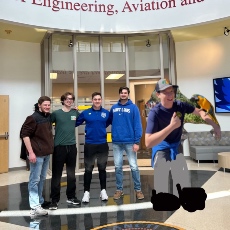 VFS Design-Build-Vertical Flight Competition
VFS Design-Build-Vertical Flight Competition
Keegan Hegger, Chris Imbriano, Will Jackson, Caleb Kasten, Anthony Rizzo
The team is participating in the annual Vertical Flight Society's Design-Build-Vertical Flight competition. For the competition, the team will design and build a large quadcopter within a given set of parameters provided by the Vertical Flight Society. The mission requires a vertical takeoff aircraft to complete as many laps around a 1km course as many times as possible while being as fast as possible. The quadcopter is limited to a 20-pound maximum weight and is estimated to have dimensions 4.5 ft x 4 ft x 1 ft. Based on the way points are awarded to teams, the quadcopter has been designed to carry a heavy payload and gain the most points by having the heaviest payload.
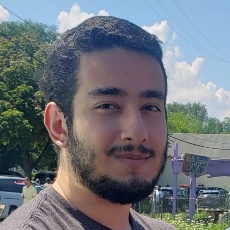 3D-Printed Bioreactor for Longitudinal Ultrasound Stimulation of Bone Cells
3D-Printed Bioreactor for Longitudinal Ultrasound Stimulation of Bone Cells
Ahmed Mahmoud
Ultrasound Stimulation for the use of bone repair has been on the market for over 25 years, and has been shown to radiographically improve bone healing for delayed or non-union bone fractures. However, the mechanistic understanding of how the ultrasound stimulation is transduced to elicit altered cellular behavior is not well understood, especially in longer term applications. We propose a novel acoustically permeable 3D-printed bioreactor for the study of longitudinal ultrasound stimulation of bone cells seeded in a 3D cryogel scaffold.
 A Novel Device for Producing Mono-Dispersed Polyethylene Glycol (PEG) Microspheres
A Novel Device for Producing Mono-Dispersed Polyethylene Glycol (PEG) Microspheres
Parul Nigam
This project focuses on designing a microsphere manufacturing device that will produce mono-dispersed microspheres. The microspheres need to be of the appropriate shape and size. The device is composed of two cylindrical tubes: one stationary outer tuber and a rotating inner tube. The inner tube acts as a rotating drum to help form the microspheres. A timing belt pulley system along with an Arduino and servo motor rotates the inner tube. An application of the microspheres is for them to be inherently radiopaque and have an appropriate attenuation value, which is tested with MicroCT imaging.
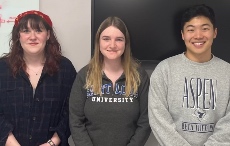 Analog Leg Pressure Sensor System
Analog Leg Pressure Sensor System
Bridget Boland, Angie Carey, Sean Kim
Deep vein thrombosis (DVT) can affect sedentary patients who do not get much use of their legs or have been sitting for extended periods of time. The Kendall SCD Smart Compression system is an innovative device designed by Cardinal Health that produces a fruitful solution to combat such conditions. Our project's objective is to see exactly how the compression system affects pressure both outside and inside the leg. The internal pressure will be found using an analog leg that has pressure sensors implanted inside the system. The external pressure will be found by wrapping a pressure sensor map between the compression sleeve and the analog.
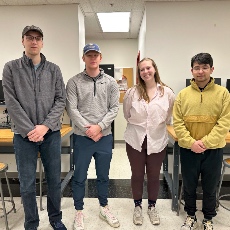 ArmWare Prosthetics 4B
ArmWare Prosthetics 4B
Shakhboz Hasanov, Matthew Draper, Caroline Smyth, Arthur Sosin
The ArmWare Prosthetic is a 3-D printed myoelectric prosthetic hand for below-elbow amputees. Electromyography (EMG) sensors placed on the arm allow the user to control input by contracting their muscle. This input, processed via Arduino, activates the servo motor to pull on or release strings threaded through the fingers, controlling contraction of the hand and allowing the user to grasp and pick up objects. The body of the prosthetic is a 3-D printed forearm and hand movable finger joints,which encase the hardware. This device offers greater independence to amputees at a low cost. While currently this is targeted as a myoelectric prosthetic hand for below-elbow amputees, the core concepts can be used to expand into greater prosthetic markets.
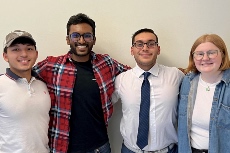 Customizable 3D Bioprinter
Customizable 3D Bioprinter
Ali Hamed, Aakash Nagarapu, Nick Navarrete, Claire Lois
A common problem in many research labs evaluating cellular responses to stimuli is the inability to build irregular 3D scaffolds of various materials and stiffnesses to evaluate cell propagation. Based on a series of proposed modifications to an Ender Pro 3 printer presented by a team at Texas A&M University, we aim to bring 3D bioprinting technology to biomedical engineering research labs to provide a new method for scaffold design. Using a 3D printed method that has the capability to utilize UV crosslinking would allow for more precise designs that can be repeated for multiple experiments. In this project we aim to design and implement modifications to an Ender Pro 3 printer and print biocompatible scaffolds. Further, we aim to develop a unique polymer blend conducive to 3D printing.
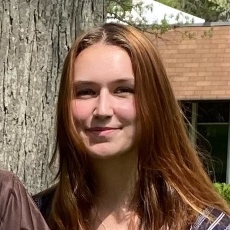 Development of a Matlab Code for Efficient and Robust Analisys of Microscopy Images
of Glioblastoma Cells and Cell Spheroids
Development of a Matlab Code for Efficient and Robust Analisys of Microscopy Images
of Glioblastoma Cells and Cell Spheroids
Alli Faber
Glioblastoma multiforme (GBM) is an extremely aggressive form of brain cancer with limited treatment options. Understanding how this cancer behaves in the brain environment will be critical to developing and introducing new treatments. Current research has focused on replicating aspects, if not all, of the GBM niche. To properly replicate this microenvironment, images of the glioblastoma cells within the manufactured system are required. Due to the large number of images needed throughout the project, an efficient method for cell analysis was sought with the development of a Matlab code. The created MatLab code produces a live/dead assay of 2D and 3D culture of dissociated cells and spheroids with ±5% accuracy.
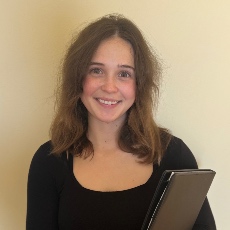 Distal Third Tibia Fracture
Distal Third Tibia Fracture
Tabitha Cacheris
For my project, I created a testing protocol to load a distal third tibia fracture into a MTS machine to examine the strengths and durability of specific plates and screws fixated onto the bone.
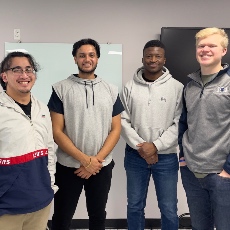 Glove Perforations
Glove Perforations
Isaac Beck, Mohit Grewal, Tyree Hicks, Ray Cedric Solijon
Glove perforations occurs often in the surgical room. This project is not to make
a glove that prevents perforations but detecting those perforations. Our project is
using a camera to detect the perforations. This is done by making use of the fact
that most surgery's have a double layered gloves and they are different colors. Our
camera detects the color of the under glove to detect a perforation of the top glove.
 Improving Extracellular Vesicle Stability and Bioavailability through Electrostatic
Nanoparticle Encapsulation
Improving Extracellular Vesicle Stability and Bioavailability through Electrostatic
Nanoparticle Encapsulation
Connor Tobo
Extracellular vesicles (EVs) derived from mesenchymal stem cells (MSCs) contain bioactive
molecules (e.g., proteins, microRNAs) unique to the cell of origin, making them beneficial
for tissue regeneration. However, EV administration in vivo results in rapid clearance
from the bloodstream, and retaining them in damaged tissues for a prolonged period
is difficult. This project aims to enhance the therapeutic potential of EVs by preventing
their clearance and degradation after administration.
To achieve this, we prepared gelatin nanoparticles (GNPs) using the desolvation method.
By adjusting the Type A and Type B gelatin solution to pH 4.0 or pH 8.0 before the
desolvation step, we imparted a net positive or negative charge on the GNPs. The hydrodynamic
size and the zeta potential of the positively charged GNPs were 64 nm and 8.5 mV,
respectively, while that of negatively charged GNPs was 55 nm and -4.6 mV. Preliminary
studies suggest that positively charged GNPs can be taken up by fibroblasts and are
not cytotoxic. We confirmed the electrostatic attachment of positively charged GNPs
to negatively charged MSC-EVs by observing a shift towards a larger hydrodynamic size
and lower zeta potential. Future studies will investigate the impact of unmodified
and GNP-modified MSC-EVs on myoblast proliferation, differentiation, and myokine secretion.
 Infrared Image Recognition
Infrared Image Recognition
Olivia Widdoes
Thermal Infrared Imaging is a growing field of image recognition with potential to significantly improve the safety of our daily life, applicable to car safety and home surveillance. I interfaced a MLX90640 (a mini-thermal imaging camera) with a Raspberry Pi Pico. I programmed the Raspberry Pi with CircuitPython, brought the sensor data directly into the PC as a 2D array of values, then manipulated the data to display a heat map. I also explored other Raspberry Pi boards and manipulations. This work relates to a larger project with Dr. Gai, which explores various machine-learning algorithms in the classification of digits captured by infrared sensors. To do this, we constructed the linear-discriminant analysis (LDA) and also adapted a spiking deep belief network. The ultimate goal is to develop a real-time system that performs infrared image classification for various safety applications.
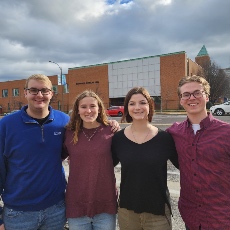 Powered Hand Orthotic for Paralysis Patients
Powered Hand Orthotic for Paralysis Patients
Jeremy Roenker, Aakash Nagarapu, Madi Person, Meghan McCabe
Approximately 50 million people worldwide experience hand impairments as a result
of stroke and spinal cord injuries [1]. Individuals without bimanual hand function
experience a loss of independence when completing daily activities, such as picking
up a water bottle. In an effort to reinstate bimanual hand function within this population,
wearable robotics are being developed. Although there has been significant advancement
in current technology, present designs struggle to develop a solution that fully mimics
the complex dexterity of the human hand without harming the user [1]. Moreover, most
solutions only provide the user with the ability to flex their fingers to grasp objects
but do not assist in releasing. Although the assistance in grasping objects is beneficial
for individuals with partial control of their hand, this design would not allow those
with complete hand paralysis to pick-up and release objects. Implementation of a glove
that allows for finger extension, grip assistance, and object release has the potential
to reduce the physical and mental effort required to perform bimanual tasks while
allowing the individual to perform daily living tasks.
Group 3’s proposal for a solution to restore the ability to pick-up small objects
in individuals experiencing hand paralysis as a result of stroke is a powered orthotic
glove that utilizes small actuators to generate finger movements that replicate normal
hand function. Our approach will include a voice recognition input component that
allows the user to speak to open and close the glove, and then an output response
will be produced by soft actuators integrated on the back of the glove controlled
by an Adafruit feather bluefruit system.This design will fulfill the predetermined
requirements needed for the powered orthotic glove, including that the glove portion
will weigh less than 0.5 kilograms while the waist belt will weigh less than three
kilograms. Additionally, the design will have multiple joint control such that each
finger will have three bending degrees of freedom and the thumb will have two degrees
of freedom. Furthermore, the design will allow an individual to grasp and pick up
an object that weighs between 70 kilograms, such as an egg. This design proposal will
produce a glove that can be worn by individuals who suffer from hand paralysis to
pick up everyday objects, allowing them to regain a sense of independence in their
lives.
 Robotic Glove for Patient with Hand Paralysis
Robotic Glove for Patient with Hand Paralysis
Olivia Johnson, Claire Mitchell, Emily Nunn
The voice activated robotic glove is a proposed solution to assist individuals facing hand paralysis with fine motor manipulation skills. An injury resulting in impairment to one or both hands strips away one of the body’s vital tools for self-sufficiency. The design described in this report will produce an AVR microcontroller driven system that will use voice commands to induce finger movements. More specifically, implementing this light-weight and portable embedded system in the robotic glove will make it powerful enough for the user to pick up a 70 g item, like an egg, effectively allowing individuals to regain a sense of independence. The user interface consists of a voice recognition system and multiple spring controlled linear actuators. A sound recognition sensor receives keywords from a microphone to let the user initiate the opening and closing of the glove.
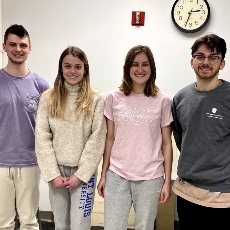 SafeKey
SafeKey
Ryan Andersen, Rowan Elwart, Adelia Grapperhaus, Lindsey Postula
This technology, SafeKey, provides a method to catalog items and determine whether those items are in a predetermined area. A box is designed and manufactured to keep a log of its contents and maintain the security of those items. If an item is removed from the box, it will alert the appropriate user to this fact. Applications of this technology could be valet stands, building manager's offices, and car share services. In general, the technology should apply to any scenario where a user wants to keep track of an item in a communal space.
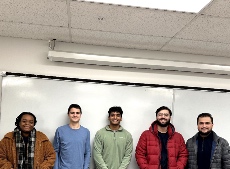 Seekster Bot
Seekster Bot
Abhinav Kumar, Jithin Martin, Nina Oforji, Rashid Ormani, Eric Suter
This goal of this project is to develop a personal-assistance robot which carries objects for a user. The user will place an object on the top of this robot and then walk to their destination with the assistant in tow following closely behind. The robot will follow a human user wearing a discrete symbol which it recognizes and knows to follow. Upon reaching the destination the user can remove objects from the robot and place them in a more permanent place. This device would restore some mobility and independence to the user who then need not rely on others to move objects for them. A target user is someone who is capable of moving relatively-heavy or otherwise difficult-to-carry objects short distances from a table/shelf to the robot, but who is not able to do so over longer distances. In essence this robot is analogous to a wagon or cart without the need to risk injury by pushing/pulling the vehicle. There is currently only one company making a product remotely similar to the proposed device, which is marketed toward wealthy technology enthusiasts who otherwise have little serious reason to use it. The goal is to recreate this technology for use in a more affordable product targeted toward people who have a serious reason to use it.
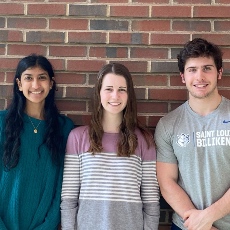 Synthesis and Optimization of Poly(DMA-co-SBMA) Polymer as a Lubricous Coating for
Microgels: Towards Application in the Treatment of Knee Osteoarthritis
Synthesis and Optimization of Poly(DMA-co-SBMA) Polymer as a Lubricous Coating for
Microgels: Towards Application in the Treatment of Knee Osteoarthritis
Andrew Schab, Grace Almgren, Maitreyi Bhagat
Osteoarthritis is a common orthopedic condition characterized by pain and loss of function in the joints. A feature of osteoarthritis is compromised mechanical properties driven by chemical changes in the synovial fluid. Biotherapies have been developed to reduce inflammation, but do not restore the mechanical properties of osteoarthritic joints. Here, we have developed lubricious hydrogel microspheres to restore mechanical properties and offer the potential for drug delivery into synovial joints. Polyethylene glycol (PEG) microspheres (100-400 μm) were fabricated via electrospraying and dip-coated into a copolymer consisting of dopamine methacrylamide (DMA) and sulfobetaine methacrylate (SBMA) monomers, forming a Poly(DMA-co-SBMA) coating. Microspheres were tested for mechanical properties such as storage modulus, injectability, and coefficient of friction. Coated microspheres were compared to non-coated microspheres and synovial fluid samples from patients with and without osteoarthritis. Future work will investigate the capability of these lubricious microspheres to deliver biotherapies, offering a dual-action treatment for osteoarthritis.
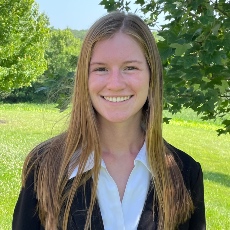 The Design of an Optimized Electrospun Scaffold for Retinal Pigment Epithelium Cell
Interaction
The Design of an Optimized Electrospun Scaffold for Retinal Pigment Epithelium Cell
Interaction
Grace Yost
The Bruch’s membrane, between the retina and choroid in the eye, provides structural and functional support for Retinal Pigment Epithelium (RPE) cells. RPE cells work with photoreceptors to maintain normally functioning vision. This project aims to create an in vitro model of RPE cells on the Bruch’s membrane. Electrospinning, a fibrous scaffold fabrication technique, is utilized for the production of a synthetic Bruch’s membrane. RPE cells are introduced to the optimized scaffold in a static flow situation to investigate the cell-scaffold interactions.
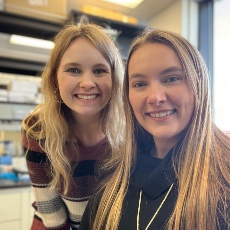 The modification of three-dimensional filament printer to produce ionically crosslinked
hydrogels
The modification of three-dimensional filament printer to produce ionically crosslinked
hydrogels
Danielle McTigue, Natalie Roush
This study aims to create ionically crosslinked hydrogels using a 3D printer. 3D printing has gained interest in tissue engineering due to its precise deposition. Hydrogels are crosslinked polymers that maintain specific structures due to their composition. A complex hydrogel with small-diameter depositions can be fabricated using a modified 3D printer. A coaxial nozzle and separate syringe pumps were utilized to push a 1% alginate and 10% CaCl2 solutions through 0.090-inch diameter tygon tubing separately at rates of 0.40 milliliters per minute and 21.00 milliliters per hour, respectively, via a 22-gauge needle. Preliminary cyclic data confirmed that the 3D-printed hydrogels have comparable mechanical properties to the current model. Hydrogels fabricated with decreased flow rates produced diameters of 2 microns congruent with replicating the extracellular matrix. The various two-dimensional prints had length errors beneath 5 percent. These results indicate that 3D-printed hydrogels are suitable scaffolds for use in tissue engineering.
 Three-Dimensional Confined Bioreactor for Collagen Deposition
Three-Dimensional Confined Bioreactor for Collagen Deposition
Gabriella Coronado
Collagen is an important building block for the body, especially for articular cartilage. Tissue engineering allows for collagen production experiments from cells in vitro, or outside of the body to replicate extracellular matrix structure and exhibit collagen production and accumulation from cells to initiate polymerization of procollagen outside of the cells, resulting in increased collagen formation to self-assemble into fibrils to make up articular cartilage where collagen is a prominent component. However, many methods do not produce a realistic biomimetic environment outside of the body. Existing methods are either two dimensional or involve macromolecular crowding, interfering with cells’ ability to secrete collagen due to macromolecular interactions with the cell’s surface. The confinement method will be tested in combination with the development of a 3D bioreactor to monitor the amount of collagen secretion and improve the biomimetic properties of a cell environment. The model will answer whether it is feasible to create a 3D confined model and monitor diffusion and degradation rate of materials based on the material choice including the membrane to achieve the desired outcome of increased collagen deposition like the body’s natural environment.
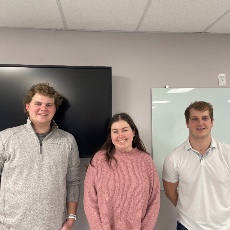 Tibia Bone Fracture Model
Tibia Bone Fracture Model
Garrett Ellebrecht, Nate Platcher, Anna Zurawski
This project is a proposal for a new fracture model that displays the biomedical properties of metaphyseal distal third tibia fractures treated with intramedullary nailing with and without provisional reduction plating. The strength and design of the model will be established using finite element method (FEM) software before the physical development of the model is completed. The need for this model is demonstrated mainly in orthopedic surgery to understand the advantages and disadvantages of reduction plating, as there are patients with open, type III fractures that require surgical repair. Currently, there are no tibia models used in these applications, so it is difficult for orthopedic surgeons to understand or develop new methods of fracture treatments. Although the immediate application is to demonstrate how different methods of reductional plating affect tibia healing, this model could lead to further development of fracture models of other long bones.
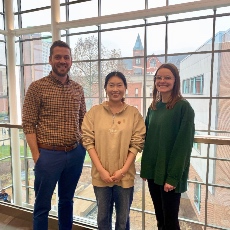 A Research-Based Capstone Project for Organic Chemistry Lab
A Research-Based Capstone Project for Organic Chemistry Lab
Kristen Kamp, Brian Woods, Louisia Yang
A multi-week research-based project was installed at the end of the two-semester organic lab sequence for chemistry majors. Up to this point in their academic careers, organic students (primarily sophomores) are adept at performing lab experiments that follow a thorough stepwise protocol. However, they have little experience with open-inquiry type labs or the research process. Most chemistry majors join a research group in their junior year, so this project was designed to introduce students to a research-like project. Collectively, the students performed a two-step synthesis of a series of molecules that have potential anti-bacterial activity. Working in groups of two, students were assigned a target molecule to synthesize, characterize, and report their results. The development and implementation of the pilot versions of this project will be presented, as well as lessons learned along the way.
Counter-screening N-hydroxynapthyridinones (HNOs) and N-hydroxypyridinediones (HPDs) Against Human Ribonuclease H 1
Mahima Bhasin; Daniel Bradley; Jala Chalichama; Holly Furby; Emma Inmon; Alaina Knier; Qilan Li; Anna Pan; Annabella Robinson; Razia Tajwar; John E. Tavis; Molly Woodson
Hepatitis B virus (HBV) chronically affects over 290 million people worldwide and kills up to 820,000 people yearly by inducing liver failure and liver cancer. Hepatitis B virus (HBV) is a double stranded DNA virus part of the hepadnaviridae family. It replicates using reverse transcription. Inhibiting the HBV ribonuclease H (RNase H) can prevent HBV replication. The N-hydroxypyridinediones (HPDs) and N-hydroxynapthyridinones (HNOs) are known HBV inhibitors. Human RNase H 1 and HBV RNase H are similar in structure and metabolic activity, so counter-screening of huRNase is essential. From all the compounds screened, the HNOs had the highest inhibitory effect on huRNase H 1. The HPDs had the best overall response to HBV (SIHBV) and were not extremely toxic to huRNase H 1. Compounds 1465, 1466, 1467, and 1618 have the best overall SI values. They are not the most potent, and they have decent antiviral activity.
 Optimizing measurement of flavin reduction potential upon aptamer binding using spectroelectrochemistry
Optimizing measurement of flavin reduction potential upon aptamer binding using spectroelectrochemistry
Regan Orr
The ability of biomolecules to bind to and change the properties of redox cofactors expands their potential reaction scope. Previously we have identified RNA aptamers capable of preferential binding to oxidized forms of flavin and subsequently shifting the reduction potential. The reduction potential shifts were determined using the enzyme xanthine oxidase. Specifically, xanthine oxidase reduces a common mediator, which then reduces the flavin and a reference dye in a spectroscopically monitored competitive assay. While aptamer binding was observed under a variety of conditions, the use of enzymes limits the conditions under which the reduction potential can be determined. Spectroelectrochemistry reduces the common mediator electrochemically and monitors the competition assay spectroscopically. Spectroelectrochemistry has been used for the study of proteins, but it has not been applied to aptamer characterization. Using our previously reported aptamer, we have investigated the ability to use spectroelectrochemistry for measuring reduction potential changes for aptamer-bound redox cofactors.
 Progress in Thermodynamic Characterization of RNAs Containing Inosine for Improved
Structure Prediction
Progress in Thermodynamic Characterization of RNAs Containing Inosine for Improved
Structure Prediction
Kip Friend, Danyang Liu, Brent Znosko
Inosine is a naturally occurring non-canonical nucleotide often found in the wobble position of the tRNA anticodon loop that has been known to increase transcriptome diversity due to its ability to form base pairs with cytosine, uracil, and adenine. While Inosine has previously been studied and nearest neighbor parameters derived for I•C and I•U base pairs, there remains a need to characterize inosine when it occurs in other types of secondary structure motifs. Zuber et al. identified a subset of nearest neighbor parameters which have the greatest impact on secondary structure prediction, highlighting dangling ends, terminal mismatches, and internal loops as motifs of key importance [Zuber, J., Hongying, S., Xiaoju, Z., McFadyen, I., and Mathews, D.H. (2017) Nucleic Acids Research 45(10), 6168-6176]. In the present work, RNAs containing inosine within these key motifs are being thermodynamically characterized using optical melting experiments. To date, ten duplexes have been purified and optically melted. Ultimately, when data collection is complete nearest neighbor parameters will be derived and incorporated into an improved model for accurate prediction of the stability and secondary structure of RNAs containing inosine.
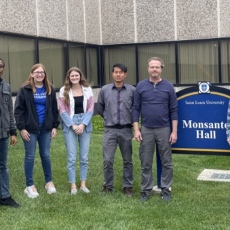 Integration of Electrodes into 3D Printed Microfluidic Devices with Electrophoresis
Applications
Integration of Electrodes into 3D Printed Microfluidic Devices with Electrophoresis
Applications
Molly Melzer, Major Selemani, Emily Currens, Dr. Scott Martin
The application of stacked PolyJet printing utilizing stage drops and multiple prints has allowed for the embedding of capillaries and electrodes in microfluidic electrochemical devices. The implementation of carbon ink and gold 100-micron diameter electrodes has been pursued for capillary electrophoresis with electrochemical detection. Two separate device designs have been investigated, both using stacked PolyJet printing. The first uses liquid support, a gold electrode, and embedded capillary and the second uses a brass mold to form channels, a carbon electrode, and thermal bonding to secure the print with channels to the print with the carbon electrode. Separations of catechol, epinephrine, norepinephrine, and dopamine using grounded and floating potentiostats will be presented. Using a 3D printing approach for electrochemical devices allows rapid and customizable production of detection devices allowing quick changes in electrode types and design and quick turnarounds for same day to day after print detection.
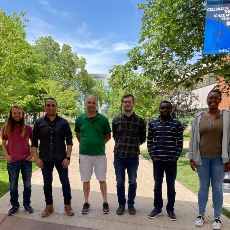 Isobaric 6-plex and tosyl dual tagging for the determination of positional isomers
and quantitation of monounsaturated fatty acids using rapid UHPLC-MS/MS
Isobaric 6-plex and tosyl dual tagging for the determination of positional isomers
and quantitation of monounsaturated fatty acids using rapid UHPLC-MS/MS
Michael Armbruster, Christopher Arnatt, Rhea Caldwell, James Edwards Mahmoud Mostafa, Scott Grady
Unsaturated fatty acids are notoriously difficult to separate and quantitate which result in longer separation and analysis times. Our derivatization approach multiplexes fatty acids using two tags which yield individualized fatty acid reporters. Using this strategy, we were able to simultaneously separate and quantitate 16 different fatty acids with a single sample injection. The derivatization strategy utilizes two tags: a quaternary amine 6-plex isobaric tag for separation efficiency and quantitation, and a chloramine-T tag for double bond identification. Upon derivatization, the fatty acids were separated and analyzed with reverse phase ultra-high-performance liquid chromatography (RP-UHPLC) coupled with tandem mass spectrometry. 16 fatty acids standards were separated using a 3.5-minute RP-UHPLC method resulting in 14 of the 16 standards having resolutions greater than one. Each fatty acid standard was quantified using a characteristic reporter fragment. This strategy improves the signal-to-noise ratios and increases the peak resolution for the quantitation of fatty acids.
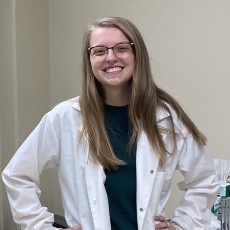 Expedient Synthesis of Thioglycosyl Superarmed Donors
Expedient Synthesis of Thioglycosyl Superarmed Donors
Emma Mize
Thioglycosides are common building blocks used in synthesis of biomedically relevant compounds. Our group discovered an unusually reactive class of thioglycosides that we named “superarmed building blocks.” The superarming reactivity was achieved via modulating protecting groups. Despite high reactivity and potential broad application in synthesis, building blocks equipped with the superarming protecting group pattern are tedious to prepare. For example, the synthesis of superarmed thioglycosides requires six or seven synthetic steps, several chromatographic purifications of intermediates, the use of toxic reagents, and may lead to weeks of benchwork. Poor accessibility to sugar building blocks in general, hampers the development of many therapeutic agents and diagnostic platforms. Reported herein is a streamlined approach to the synthesis to super-armed building blocks equipped with thioethyl, thiophenyl, and thiotolyl anomeric leaving groups.
 Synthesis of Potential p38β Selective PROTACs
Synthesis of Potential p38β Selective PROTACs
Ethan James
Facioscapulohumeral muscular dystrophy (FSHD) is a debilitating neuromuscular disease with no known cure. Misexpression of the DUX4 gene causes progressive muscle degeneration in patients with FSHD, and the p38 mitogen-activated protein kinase (MAPK) is an important regulator of DUX4 activity (1). The p38β isoform has been identified by our group as a target for selective degradation when treating FSHD, and PROTAC (Proteolysis-targeting chimera) molecules are being developed accordingly. PROTACs are heterobifunctional molecules used in targeted protein degradation, consisting of a “warhead” ligand that binds the protein of interest and an E3 ubiquitin ligase binding ligand, connected by a linker (2). Experimental PROTAC molecules have been synthesized by attaching a warhead with a known affinity for p38 to VHL and CRBN ligands, connected by alkyl and PEG linkers of differing lengths, in addition to other moieties affecting linker rigidity. In the future, SAR studies will be used to inform further synthesis of PROTACs.
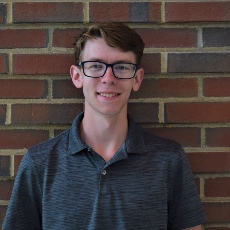 Thermodynamic Characterization of RNA Hexaloops
Thermodynamic Characterization of RNA Hexaloops
Jonah Koch
Prediction of RNA tertiary structure from sequence first relies on the prediction of secondary structure using free energy minimization. Hexaloops, hairpins with six nucleotides in the loop, are a common RNA secondary structure motif; however the current model used to predict their stability derived from data collected for hairpins of various sizes. Here, 19 hexaloops that are common in nature were optically melted to determine the thermodynamic parameters ΔH, ΔS, ΔGo37, and TM. By combining this data with 107 previously melted hexaloop sequences from the literature, a new hexaloop-specific model to predict free energy contribution was derived using a multivariable linear regression. Compared to the current model, this new model is more accurate and simpler to use. This updated model and new experimental data can be used in secondary structure prediction software to generate more accurate results.
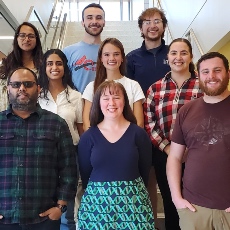 Determining the reduction potential shifting ability of flavin-binding DNA aptamers
Determining the reduction potential shifting ability of flavin-binding DNA aptamers
Blake Recupido
Aptamers are identified based on their ability to bind to specific molecules. However, upon binding, aptamers can also impact the properties of their ligands. Recently, we have reported the ability of a flavin-binding RNA aptamer to shift the reduction potential of the bound flavin. To explore if DNA aptamers have similar abilities, we have undertaken a series of spectroscopic assays on recently reported DNA aptamers for flavin adenosine dinucleotide (FAD) and riboflavin. Flavin binding has been assessed in the presence of different divalent metal ions and under a range of pH conditions. The reduction potential of the bound flavin is being analyzed using a previously reported xanthine oxidase enzymatic assay as well as by spectroelectrochemistry. The results of these studies are expected to reveal reduction potential shifts, if any, by DNA aptamers and will contribute to the understanding of DNA’s impact on flavin redox behavior.
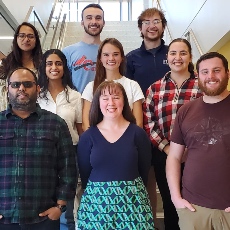 Identification of DNA Aptamers for IL-17 and IL-20 for Psoriasis and Diabetic Wound
Healing
Identification of DNA Aptamers for IL-17 and IL-20 for Psoriasis and Diabetic Wound
Healing
Kirsten Sully
Two interleukins are implicated in the pathophysiology of the diabetic wound healing process namely Interleukin 17 (IL-17) and Interleukin 20 (IL-20). IL-17 is a proinflammatory cytokine while IL-20 induces keratinocyte proliferation. Currently, antibodies exist for both IL-17 and IL-20, but no other biomolecule therapeutics, such as aptamers, could overcome some of the challenges associated with antibodies. DNA aptamers are a preferable over antibodies for inhibition due to cost and improved stability. Using a magnetic bead based systematic evolution of ligands by exponential enrichment (SELEX) approach, potential aptamers for the IL-20 protein have been isolated and sequenced and experimentation is underway to determine binding affinity and to compare with known RNA aptamers. For IL-17, we have completed the SELEX rounds and are commencing with cloning to isolate potential aptamers for testing and comparison with recently reported DNA aptamers. Our progress on these characterization studies will be discussed.
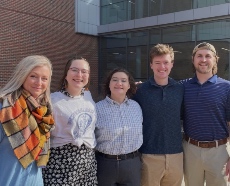 Iron-Catalyzed Linear Trimerization of Terminal Alkynes
Iron-Catalyzed Linear Trimerization of Terminal Alkynes
Celia McGhiey, Jamie Neely, Madeline Stockell, Mitchell Vandercar
Catalyzed trimerization of terminal aryl alkynes proves to be a useful and efficient way to form C—C bonds. However, this process favors the formation of substituted benzene derivatives, which is reported in all but one previous study. To combat this issue, we have discovered an electron-rich iron (II) complex, tBuLFeOEt2, in which tBuL is a bis-pyrrolide pyridine pincer ligand. This complex selectively creates linear 3,5-diene-1-yne products, which are more synthetically useful intermediates than the cyclic products created without the catalyst. The linear products of interest can be made with both electron-rich and electron-poor terminal aryl alkyne substrates. Product selectivity and yield are affected by the reaction concentration and solvent. Current work is focused on studying the substrate scope of this catalyst as well as the isolation and characterization of the linear trimerization products.
 Investigating the Reactivity of Differently Protected Galactosyl Chlorides
Investigating the Reactivity of Differently Protected Galactosyl Chlorides
Shirley Syed
Koenigs-Knorr reaction conditions classically involve the glycosidation of a glycosyl halide donor with a glycosyl acceptor (alcohol) in the presence of a silver salt as an activator. Traditionally, the per-O-benzylated (armed) donor is more reactive under these conditions than the per-O-benzoylated (disarmed) donor. However, recently discovered reaction conditions have indicated a reversal in this traditionally understood reactivity trend. In this project, we are investigating the reactivity trends of differently protected galactosyl chlorides in a cooperatively-catalyzed Koenigs-Knorr glycosylation reaction.
 Effects of Atomic Oxygen on Cell Biology using Dibenzothiophene S-Oxide Derivatives
Effects of Atomic Oxygen on Cell Biology using Dibenzothiophene S-Oxide Derivatives
Bashar Aziz, Ankita Isor, John Petroff, Ryan McCulla
Reactive oxygen species (ROS) have proven invaluable in extracting vital molecular information in various bioanalytical techniques. However, we are particularly interested in investigating the potential of atomic oxygen, O(3P), in these methods because compared to other ROS, O(3P) has a higher selectivity for electrophilic oxidation of alkenes and thiols. Unfortunately, previous research on cellular responses to O(3P) has been limited due to the harsh conditions required to generate O(3P) and the associated by-products. To address these challenges, we have synthesized 2,8-diaxetoxymethylDBTO, a water-soluble molecule that produces O(3P) upon UV-A irradiation through photodeoxygenation. With this clean source of O(3P), we can now study the effects of O(3P) on cell viability, gene expression, and cell cycle distribution.
View this poster project
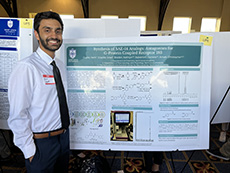 Synthesis of SAE-14 Analogs: Antagonists for G-Protein Coupled Receptor 183
Synthesis of SAE-14 Analogs: Antagonists for G-Protein Coupled Receptor 183
Varin Gupta
The management of neuropathic pain (NP) targets opioid receptors to modulate their signal transduction and this is known to have side effects such as addiction and dependencies. GPR183 (Epstein-Barr induced gene 2, EBI2) is a non-opioid receptor involved in NP generation. SAE-14, a novel small molecule was shown to antagonize GPR183 and mitigate the development of NP. We aim to investigate the structure-activity relationship of SAE-14 by synthesizing its analogs. This will optimize the functional groups and pharmacophores responsible for the binding interaction of this small molecule.
 Forest Park Trolley Extension Project
Forest Park Trolley Extension Project
Urja Gajera, Donovan Jones, Adrian Martin, Francis Peters
The Forest Park Trolley Extension Project is an urban revitalization project located in St. Louis, Missouri. The project consists primarily of a rail extension to the existing Loop Trolley, which services the Delmar Loop and Forest Park. Structural analysis and design, stormwater analysis, foundation design, and vertical and horizontal alignment design was completed in the development of this project. The extension will include 1200 ft of additional track into the Forest Park end of the alignment, from the Missouri History Museum where the track currently ends, to the Dennis & Judith Jones Visitor Center. The project also includes the design of trolley shelters located at the two additional trolley stops, an overhead cable system to power the trolley, and roadway improvements at the intersection of Grand Drive and DeBaliviere Circle. The goal of this project is to encourage cross-travel between Forest Park and the Loop, and to make the service more convenient.
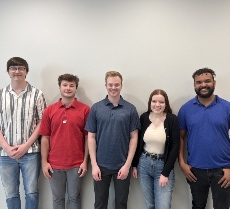 Lindell-Olive Redevelopment
Lindell-Olive Redevelopment
Cooper Chiburis, Brandon Hoff, Kelsey Hoover, Kayden McCullough, Harrison Wooters
Crossroads Consulting, a senior design team, was tasked to redevelop the northeastern plot of land near McDonnell Douglas Hall and the Lindell-Olive intersection that aimed at improving Saint Louis University’s (SLU) campus. The first element of the project was to redesign the Olive-Lindell intersection to improve pedestrian safety, traffic flow, and mobility in the area. Currently this intersection is a busy crossroad that links SLU’s campus to the surrounding metropolitan area of St. Louis, and it has been the scene of several accidents and frequent time delays. The second element of the project is implementing and designing a new dining hall for SLU. The dining hall will provide new dining options for students that spend most of their time east of Grand Blvd. The team sought to create a space that would serve as an option for community gathering, dining, and entertainment. Overall, the Lindell-Olive Redevelopment project supplied an excellent platform for students to showcase their creativity, critical thinking, leadership, and design abilities.
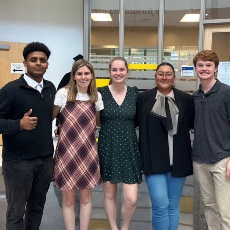 Midtown Vertical Garden
Midtown Vertical Garden
Amelie Buchard, Jess Garcia, Salim Nur, Bonnie Peccola, Jacob Reznikov
Beyond BeLeaf is an advocate for increasing green spaces on SLU’s campus. The proposed location is the unused lot on SLU’s North Campus at the intersection of Grand Boulevard and Laclede Avenue to enhance greenery, stimulate biodiversity, and foster knowledge and education for the Midtown community. The proposed Midtown Vertical Garden is a two-story, open-air structure that would provide three levels of space for plants and people to flourish. The structure has been designed to be made of steel and reinforced concrete slab to build the garden upward and increase the amount of space available for use. The whole project encompasses the structure, a parking lot, and a bioretention basin. The Beyond BeLeaf team is proud to present the Midtown Vertical Garden as an innovative way of designing urban green spaces.
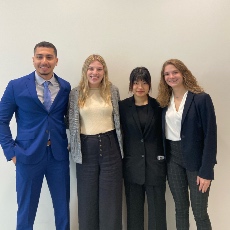 The Brewhouse
The Brewhouse
Kateri Heithaus, Shenouda Kamal, Nguyet Nguyen, & Katie Zalewski
Arch Engineering STL is pleased to design a new dining and entertainment option on campus – The Brewhouse. The Brewhouse will be located on the southwest corner of the half-acre plot of land between Oliver Hall and Hermann Stadium. The project site is located near Hermann Stadium and Chaifetz Arena, which will bring many fans to campus and increase the number of customers to The Brewhouse.
Arch Engineering STL considered three alternatives and finalized the design that best fit our client’s requirements. The design of The Brewhouse considered many different aspects including the structural integrity of the building, the foundation, hydraulic design, transportation travel demand, and the civil site plans. The team created a schedule and cost estimate for the design and construction process to finalize the plans of The Brewhouse. The goal of this project is to provide students with more dining options and social areas to convene.
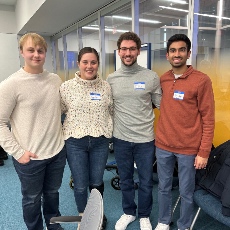 Controlling a Swarm of Drones
Controlling a Swarm of Drones
Logan Blaesing, Kunj Patel, Taylor Streff
Controlling a Swarm of Drones is a project involving the use of virtual reality (VR) to control a set of drones. The goal of this project is to allow users to issue commands through a VR headset in which a specified number of drones will execute those tasks. These commands include but are not limited to: takeoff, land, formation flying, and patterns. Added functionality will support users being able to hand off drone control to another user. Future development and scalability will introduce this novel technology into fields such as emergency services, surveillance, and law enforcement.
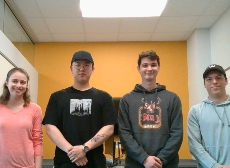 Machine Learning Code Generator
Machine Learning Code Generator
Kaitlyn Ashabranner, John Coffman, Boran Li, Tyler McMahon
Machine Learning Code Generator is an open-source web application that models the work of machine learning experts and allows users to generate machine learning code through a simple graphical user interface. The goal of this project is to allow people to use machine learning code to analyze data without requiring familiarity with writing machine learning code.
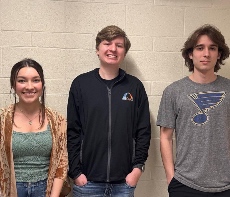 Mouser
Mouser
Tyler Bush, Cori Diaz, Logan Wyas
Mouser is a desktop application designed for animal testing research. The goal of the application is to automate data entry and storage in a laboratory experiment, allowing a researcher little computer interaction while in the lab environment. Animals in an experiment are embedded with an RFID chip which can be scanned and automatically entered into the Mouser application along with other electronic measurement-taking devices. Mouser also features a login system with restrictions for administrator-identified features for differing clearance levels.
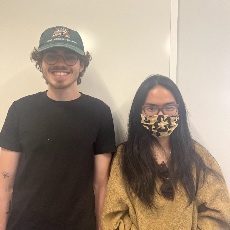 Network Congestion Control Emulation
Network Congestion Control Emulation
Andrew Berry, Anh Nguyen
Congestion control is a mechanism used to control the arrival of data packets into a network, enabling a better use of a shared network infrastructure and avoiding any collapse within the network. Over the years, different congestion control protocols have been developed in response to observed congestion and collapse while fully utilizing the bandwidth of the network. These protocols use different network algorithms to avoid congestion therefore, it is hard to compare them when subjected to the same network conditions. This project aims to optimize an existing network emulation system that evaluates these different protocols by subjecting them to the same emulated network scenarios. We leverage two different open-source software- Pantheon and Mahimahi which allow users to achieve this goal. We optimize the emulation system by combining the two applications into a single software and adding more functionalities such as traffic prediction and real-time monitoring of the network.
 Pi4Micronaut
Pi4Micronaut
Traison Diedrich, Austin Howard, Sinuo Liu
The Pi4Micronaut Library empowers creators to create custom IoT applications by combining Raspberry Pi microcomputers and specialty hardware. Pi4Micronaut is based on the use of embedded applications via the Micronaut Framework and Pi4J, a java library which allows the Raspberry Pi and hardware to communicate with each other. Combined with our library, anyone can easily plug in a variety of hardware components, LEDs, Rotary Encoders, RFiD scanners, LCDs, and more, to a Raspberry Pi and create a remotely-accessible, serverless application without the hassle of understanding the intricacies of how each hardware component works. While we only offer support for a small number of hardware components now, in the future we plan to offer support for almost any component a Raspberry Pi can handle. Using our library, we have already built a remotely-accessible attendance system using RFid cards and scanners, but the possibilities are endless.
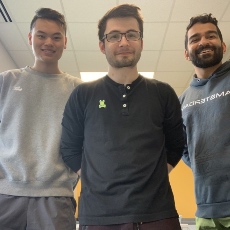 Seeing is Believing
Seeing is Believing
Daniel Mao, Carlos Salinas, Vishnu Sivaprasad
Seeing is Believing (SIB) is a learning management tool focused on language learning. SIB is a web application that helps students improve their pronunciation of words by producing spectrograms of student's voices.
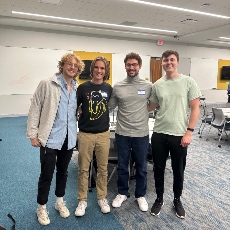 Speech Transcription and Tagging
Speech Transcription and Tagging
Omar Al Akkad, Sean Gerty, Drew Hediger, Jake Wahle
We look to be able to transcribe audio samples into a written format that is accepted by SALT (systematic analysis of language transcripts) software. SALT is an app that analyzes the speech of children and scores it according to their metrics.
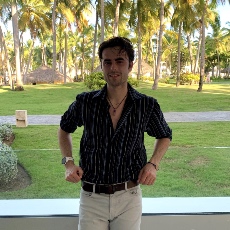 Design and Fabrication of One- and Two-Dimensional Semiconducting Nanomaterials and
Heterostructures for Low-Power Electrical Applications
Design and Fabrication of One- and Two-Dimensional Semiconducting Nanomaterials and
Heterostructures for Low-Power Electrical Applications
Marcus Lespasio
The study of nanomaterials, especially their integration into nano-scale electronics, remains at the forefront of contemporary research developments. As technology shrinks in size, a need to maintain performance and low-cost solutions arises. Many such materials exhibit semiconducting properties and enhanced electrical performance when their dimensions shrink as the surface area to volume ratio increases, allowing higher sensitivity and better transport. Many previous studies show the promising capabilities of one- and two-dimensional materials, and when combined into heterostructures, they exhibit new capabilities. Some materials that have shown such unique behaviors are Graphene (Gr), Zinc Oxide nanowires (ZnO NWs), and Molybdenum Disulfide (MoS2). In this study, we compare the electrical performance of ZnO NWs/Gr and ZnO NWs/MoS2 heterostructures, especially related to their semiconducting properties and viability to be marketed as diodes or other circuit elements in the electronics industry.
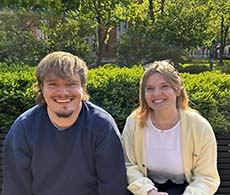 The Effects of Gamma Radiation on Microwave Resonators in Various Materials
The Effects of Gamma Radiation on Microwave Resonators in Various Materials
Grant Osmon and Abigail Sohm
Microwave resonators are a fundamental component in microwave-based communication circuits and are present in everyday devices such as amplifiers, tuners, filters, and oscillators. In this research, the resonators of coplanar waveguides are being studied and compared to themselves before and after being exposed to Cs-137, a source with high amounts of gamma radiation. After examining the circuit’s microwave resonators and their corresponding internal quality factors, we can see the resonators shift and the internal quality factors decrease drastically. Several circuits have been used of various materials. Currently, Niobium circuits are being printed onto intrinsic silicon wafers and being compared to Niobium circuits printed onto a thin layer of quartz. By exposing these circuits to extreme temperatures at about 67.5mK, one can see the resonators and measure their internal quality factors. Using superconducting microwave resonators to study radiation and materials will lead to better radiation detectors and lower decoherence in qubits.
2022 Student Projects
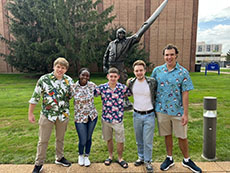 Project H.E.A.T.
Project H.E.A.T.
Robert Holzer, Brett Morgan, Tinevimbo Ndlovu, Martin O'Leary, Hunter Pritzlaff
Project H.E.A.T is developing a hybrid rocket engine test bed to demonstrate safe handling and reliable data acquisition to aid future hybrid rocket research and development at SLU. Overall, this project is one stage in a multistage process to achieve a spaceshot here at SLU, ideally by Park's College Centennial Anniversary. Currently, the overall project is in it's early stages where Project H.E.A.T. is helping to develop the engine that will power the spaceshot. Later, a rocket will be designed incorporating the lessons learned for Project H.E.A.T. and will be sent to space.
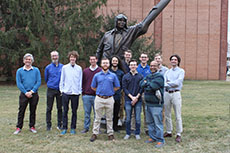 Project HIDAS
Project HIDAS
Daniel Montes
Unmanned Aerial Systems require intelligent control technology which must be able to adapt to different flight conditions and environments. Whether the system is able to effectively react to unforeseen events such as an impact is key to ensure their mission is carried out safely.
Real-time structural health monitoring can be useful to determine whether an impact has occurred, what the extent of the damage is, and how the control system should adapt to overcome these changes. One of the methods used to address this damage is measuring the resulting structural strain produced by the impact through the use of Strain Gauges. However, accurately measuring strain over the whole airplane structure at a high frequency is costly due to the sheer amount of data to be acquired and processed.
Here we show how a size, cost and power efficient high-speed data acquisition system was developed to read from more than 100 strain gauges at a sampling rate higher than 2kHz in a time-synchronized manner and send the real-time data to a main computer to be processed, as well as a method to find the proper strain gauge locations to optimize the number of sensors required.
 Project HummingBird
Project HummingBird
Justin Pointer, Hugo Holley, Wesley Hawkins, Christopher Bale, Adam Walker, Elliott Platz, Trevor Akers, Jack Wahl, Brendan Muldoon, Nicholas Morrow
Project HummingBird is a fully autonomous fixed wing aircraft with vertical take-off and landing (VTOL) capabilities, designed specifically for long duration flight to aid missing persons detection and geolocation in a heavily forested area. This mission statement is derived from The National Institute of Standards and Technology (NIST) UAS 3.1 Triple Challenge. The purpose of the challenge is to advance Unmanned Aircraft System (UAS) technologies by building and flying a UAS designed to assist first responder search and rescue operations in heavily forested areas. Specifically, the team is tasked with creating a UAS that can autonomously locate multiple missing persons in said forested area with the use of improved image detection and navigation techniques. This mission will effectively lower the search time and save more lives.
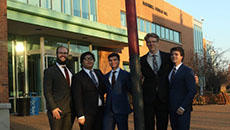 Project Silverback
Project Silverback
Apogee Precision Engineering (APE): Adis Beganovic, Antonio Bunao, Micah Reichardt, Ryne Sandler, Tristan Stricklin
Apogee Precision Engineering (APE) is developing a rocket to compete in the Spaceport America Cup. The team is participating in the student researched and developed 10,000 ft. AGL category, which sets the rocket's target apogee at 10,000 ft. The rocket, titled Project Silverback, is a single stage M-class solid propellant rocket. Much of the rocket, including propellant, avionics system, and fuselage, will be manufactured in house. The competition is scheduled for June 21-25, 2022, where APE will showcase their hard work and dedication by reaching the target apogee of 10,000 ft.
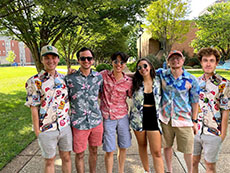 Project VULCAN
Project VULCAN
VULCAN: Declan Byrne, Scott Elliott, Jarrett Irwin, Claire Jacobs, Jeremy Ling, Patrick Sullivan
The VULCAN mission attempts to investigate the feasibility of employing additive manufacturing techniques in an on-orbit, space environment. The mission examines the potential impacts and consequences that a 3-D printer payload would have on a spacecraft in low earth orbit. This investigation is performed using two methodologies. The first investigation is the study and design of a theoretical small satellite mission with a 3-D printer payload and is done through thermal, structural, and attitude determination and control simulations. The second investigation is conducted through a series of hardware tests using a thermal vacuum chamber with the goal of characterizing the performance of a 3-D printer in a near-vacuum, space like environment. The VULCAN mission, and the corresponding research, is still ongoing, but the most recent findings are presented herein.
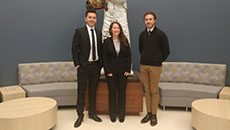 Project Quetziliken
Project Quetziliken
Quetziliken: Che-Hsien Lin, Jeremiah Polander, Jessica Smith
Quetziliken is a team of 3 Aerospace Engineering Senior Design Students creating an aircraft to compete in the SAE International Aero Design West Competition for Regular Class. The SAE Aero Design challenges engineering student with real world, engineering applications. Competing students will benefit from exposure and connections to industry professionals and will develop a fundamental understanding of aircraft design. In addition, they will become more experienced in: project management, budgeting, communication, resource management, team collaboration, applying industry rules and regulations, and developing, preparing, & presenting a technical report to customers.
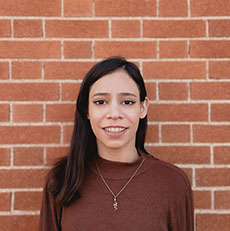 Real-time Collision Avoidance for UAVs
Real-time Collision Avoidance for UAVs
Diana Baimurzayeva
Real-Time Collision Avoidance for UAVs a survey paper summarizes and compares the
most relevant obstacle detection and collision avoidance techniques and applications
for Unmanned Aerial Vehicles.
UAVs became an important part of human life. Originally the technology was developed
for military purposes, but fast expended toward civilian’s applications. It is almost
impossible to imagine a life without UAVs, however safety is the main concern for
such a widespread use of it. Non-military UAVs have been often reported as causing
hazards to aircraft, or to people or property on the ground. Regardless of operating
conditions, a high level of safety must be maintained to achieve the same level of
autonomy as cars, such as collision avoidance with highly dynamic objects.
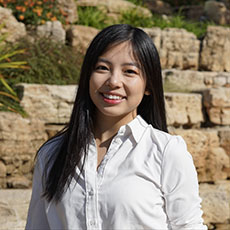 Cell Proliferation on Chemical Vapor Deposition Grown Carbon Nanotube/Zinc Oxide Nanowire
Heterostructures
Cell Proliferation on Chemical Vapor Deposition Grown Carbon Nanotube/Zinc Oxide Nanowire
Heterostructures
Emily Luc
Studies have shown the wide array of biomedical applications for nanomaterials like carbon nanotubes (CNTs) and zinc oxide nanowires (ZnO NWs). CNTs have varying mechanical, electrical, and optical properties, optimal for biomedical research. With these beneficial qualities in mind, CNTs have been used in targeted cancer therapy, biosensors, and substrates for neural growth. Zinc oxide also demonstrates biosafety and compatibility with cells, piezoelectric potentials, and antibacterial properties that may be applied to coatings. In this research, the goal is to combine the attributes of CNTs and ZnO by growing CNTs/ZnO NW heterostructures via chemical vapor deposition (CVD). PC-12 neuron-like cells will be seeded on the heterostructures to determine whether they aid in cell adhesion, spreading, and proliferation or show toxicity. It is anticipated that CNT/ZnO NW heterostructures exhibit both CNT and ZnO characteristics to applications such as regenerative engineering and drug delivery, just to name a few.
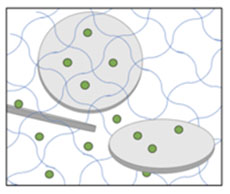 Drug Release of Docetaxel from Barium Hydrogels for the Treatment of Prostate Cancer
Drug Release of Docetaxel from Barium Hydrogels for the Treatment of Prostate Cancer
Nicholas Corker
This project is based on the drug delivery of docetaxel from barium hydrogels that have a sustained release profile. The hydrogels contain barium so the gel is imageable under CT. Docetaxel is used for treatment of the cancerous cells and we are using it for the scope of prostate cancer. The hydrogel will be able to deliver the docetaxel steadily until the hydrogel fully degrades, which is approximately 1 month. We are aiming to test if the docetaxel released from the hydrogel will kill cells from diffusion.
 In-Vitro Glioblastoma Model
In-Vitro Glioblastoma Model
Shabnam Nejat
Glioblastoma Multiforme (GBM) cancer is a vigorous and deadly brain cancer. GBM cells are very motile and infiltrate regions of the brain that are surgically inoperable which is why they’re so deadly. Research has shown that GBM cancer cells are present in the perivascular niche and migrate along areas of higher stiffnesses such as blood vessels and the white matter of the brain. The goal of my research is to develop a 3D model of the GBM microenvironment to study GBM cell invasion. In order to replicate this, U87 glioblastoma cells are encapsulated in a soft poly-ethylene glycol hydrogel. The stiff area of the “brain” is mimicked through a polyacrylamide fiber encapsulated within the poly-ethylene glycol hydrogel. The cellular movement of the U87 cancer cells in the hydrogel along the polyacrylamide fiber are observed.
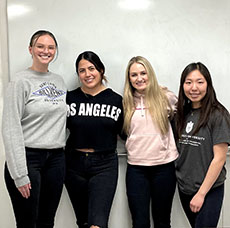 O-SafeTest
O-SafeTest
2B Or Not 2B: Courtney Castle, Emily Deng, Brooke Hudson, Ivonne Larrea
Our project is a biosensor for the detection of opioid use episodes. In order to detect opioid use, the device will measure the patient’s electrodermal activity (EDA), acceleration (movement), and skin temperature. If all three of these parameters fall outside of the normal range, the device will be able to document this and send this information to an online database. Real-time data will be collected and would alert a counselor and/or physician, as well as provide the number and date of occurrences. The product is a wearable device placed on the non-dominant wrist of the patient to allow for easy use and comfortability. This product would allow for intervention after a drug use episode, as well as more accurate and less invasive drug screening compared to current methods. As a result, patients undergoing opioid addiction counseling would be provided the best care possible.
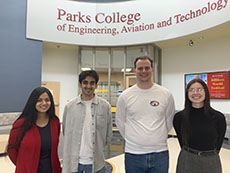 OBSense: A Wearable Biosensor to Detect Opioid Abuse Events
OBSense: A Wearable Biosensor to Detect Opioid Abuse Events
Afrida Atiar, Akbar Fidahussain, Davis Johnston, Elizabeth Redle
This project designs and proposes a non-invasive, wearable biosensor device for the detection of use of opioids. The device is intended to assist patients recovering from opioid abuse through self accountability and personalized intervention measures. The device can be worn around the wrist, and it would monitor the user’s heart rate, electrodermal activity, temperature and skin acceleration through the sensors mounted on it. The collected data would be transferred to a smart device app where it would be saved. The sensor modules would be programmed to detect deviations in the physiological signals from their respective baselines or equilibrium levels under normal conditions. Any significant deviation would be marked and saved as an event or episode corresponding to the use of opioids. A customisable alert system within the app would send notifications to the user and/or close contacts such as family members or caregivers for intervention purposes when needed. Currently, the gold standard for opioid screening is urine toxicology; physicians also rely on patients self reporting which may not always be accurate. Having access to the data in real time and being able to view the trends in occurrences of craving or relapse events, physicians would be able to tailor their treatment protocols specifically for the respective patients.
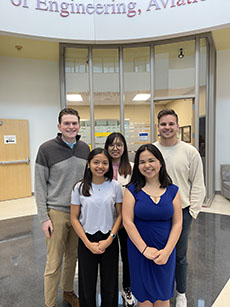 Seiz Ur Day
Seiz Ur Day
Joseph Capps, Connor Freeman, Andrea Regina Silva, Siyi Wang, Sherry Wisdom
Epilepsy is a neurological condition that is diagnosed when someone has had two or more seizures unrelated to another medical condition. Seizures are caused by disturbances in electrical activity of the brain and electroencephalograms (EEGs) are used as a diagnostic tool. The Seiz-Ur-Day device will utilize EEG technology to detect and monitor tonic, clonic, and atonic seizures. The device will use electrodes placed on the individual’s head to acquire their brain waves. Through analog and digital filtering components, the device will be able to isolate relevant information and patterns. The device uses an Arduino as a microprocessor to process and transmit the measured data. The data will then be subjected to machine learning so that there can be an improved accuracy in the detection of seizure-like data. The seizure data will then be sent through Bluetooth to an external device so that an individual can be alerted of the event.
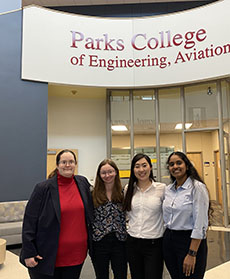 The CPR JACK
The CPR JACK
Kathleen Botterbush, Colleen McLaughlin, Ariana Monma, Jahnavi Nadella
Cardiopulmonary resuscitation (CPR) is a technique that can be used to restart one’s heart. It can be a life-saving technique, but when performed at the wrong times or incorrectly, it can cause more harm than good. To combat this, having CPR education more widely accessible is crucial. This app will allow more people to perform CPR during an emergency situation. The CPR JACK aims to provide this CPR education in an inexpensive and efficient way. It will be designed to help the user determine if CPR is required or not by running through the ABCs, as well as instruct the user on how to perform CPR by giving them step-by-step instruction with pictures to assist. One additional feature, an automatic 911 call, will also be integrated. Adalo will be used to develop this app. The end goal is to make CPR education more accessible and save more lives.
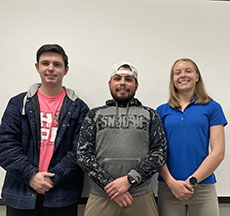 CPR Life +
CPR Life +
Gabriella Kohring, Daniel Rojo, Alex Wendl
CPR Life + is an android compatible app that provides accurate CPR instruction according to the American Red Cross Guidelines. This app utilizes a user friendly lay out combined with effective visuals to enhance user confidence in performing CPR in real time.
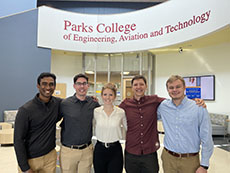 Fall Prevention through IMU-Based Standing/Fall Detection
Fall Prevention through IMU-Based Standing/Fall Detection
Cadont: Kelly Kulig, Connor McCormac, Michael Nickerson, Carl Pickhardt, Aneesh Reddlapalli
Patients falling is a major concern for various health-care settings, resulting in increased medical costs, risk of serious injury, or even death. Cadont is a fall prevention device utilizing an IMU-based standing/falling detection and alert system. Current solutions commonly utilize pressure-sensors, which are prone to false alerts and are limited to certain locations like beds and chairs. Cadont solves these problems by being a portable/wearable device that uses gyroscopic and acceleration data to detect when patients stand, the most common time for patients to fall, and alerts the appropriate caretaker. Use of accelerometers and gyroscopes allows for classification of movement potentially leading to less false-positive alerts, while still providing much needed protection for patients and peace of mind for caretakers and families.
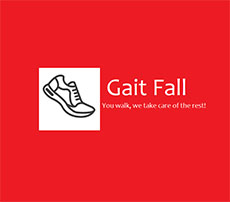 GaitFall
GaitFall
Michael Conlon, Serena Eck, Luke Kingsborough, Aaron Liekhus
The Gait Fall device would be attached to the top of the subject's ankle where the IMU components are located. If the subject becomes unbalanced or develops an irregular gait during their walk, the device will send an alert via sound and light to signal the user to correct their stance or walk. People who need this device are Elderly people who live on their own or in nursing homes and those who do not have adequate coordination or feeling in their feet. Through the use of IMU components, kinematic measurements can be taken and can provide multiple ways to detect when a person is about to fall. This device can analyze the normal walking patterns of an individual and send an alert to the individual when their gait is irregular.
 LANAH: Seizure Monitoring and Alert Device
LANAH: Seizure Monitoring and Alert Device
Anjaneé Kendall, Gabriel Prather, Eva Gierloff Romera, Ingrid Rosko
Our Design Project seeks to create a wearable device for people who suffer from seizures in order to improve their quality to life. Our device scans brainwaves to detect the onset of a seizure and then notifies the user in the advent of an episodic onset via an app. The group's device is a wearable brainwave sensor connected via Bluetooth to an app that allows the user to track their seizure activity. The app records instances of petit mal seizures and allows for long term tracking of seizure triggers.
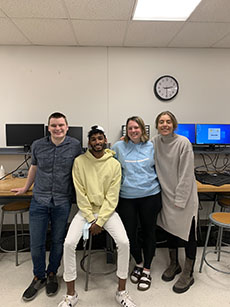 Seizure Detection
Seizure Detection
Neuro-Act: Kelly Campbell, William Kinczewski, Maria Madgalena Pereira Lopez, Rahul Ravichandran
The goal of this project is to design a device with the capabilities of tracking and detecting brain activity to identify oncoming seizures. Our team would like to positively impact the lives of people that experience seizures to make their day-to-day life unconstrained. We plan to accomplish them by designing a device that will accurately detect seizures before they occur which would trigger an audible warning. This warning would alert the individual with the seizure and surrounding individuals that an epileptic event is about to occur so that proper safety precautions and actions can be taken. The device will be created using a series of EEG electrodes, Arduino microprocessors, Bluetooth connectors, and a speaker among other components. It will process the EEG data and send a signal via Bluetooth to the speaker to tell it to alert the wearer of a potential seizure.
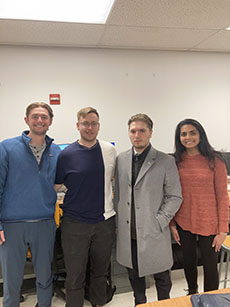 Seizure Prediction Device
Seizure Prediction Device
e6th Sense: Steven Bentley, Charles Krebs, Michael Leontiev, Deeksha Sarda
This proposal is for a wearable seizure detection device. Current seizure detection procedures require patients to be continuously monitored using electroencephalography (EEG) tests in a hospital. This process can be taxing to the patient as they have to spend multiple days and nights in the hospital with limited movement abilities. The proposed device will try to eliminate some of those problems associated with current seizure detection. To give the patient more mobility and comfort, the device will only be wired to a battery that can be stored on the patient and healthcare providers.
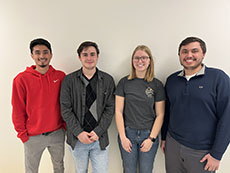 Spicer: Smart Home Product for the Visually Impaired
Spicer: Smart Home Product for the Visually Impaired
Adam Blank, Adrian Ortiz, Jaeden Sizemore, Caitlin Zoschke
The Spicer is the next smart home product that will measure and dispense your spices for you. Just tell Alexa what spice and how much you want, and the Spicer will put it in a bowl. "Hey Alexa, I want 1 tablespoon of salt!" It is that easy. This product is great for someone that is visually impaired or disabled as it helps give independence while cooking in the home.
 StatNav: A hands free device, obstacle detection for the visually impaired
StatNav: A hands free device, obstacle detection for the visually impaired
Colleen Corcoran, James David, Yuktesh Kalidindi
Implemented as an embedded system using ultrasonic sensors and haptic feedback, our device will be able to detect the distance between the user and someone or something in their path. There are motors that will vibrate at a certain frequency depending on the distance. The motors will vibrate at an increasing rate as the distance to an object decreases. We have learned that visually impaired people usually have their hands full as most have either a walking stick or guide dog in one hand, and their cell phone in the other giving GPS directions. As our device will help them avoid obstacles, we also wanted to free up their hands. This device is a hands free device, as it will be embedded into a fanny pack that can be worn across the chest or around the waist area.
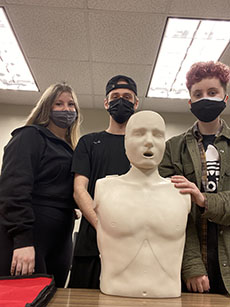 The Effect of a Real-Time Compression Depth Feedback Smart Phone Application (CPR
Guardian) on the Quality of CPR Performed by Untrained Laypeople: Results of a Within-Group
Subject Trial
The Effect of a Real-Time Compression Depth Feedback Smart Phone Application (CPR
Guardian) on the Quality of CPR Performed by Untrained Laypeople: Results of a Within-Group
Subject Trial
Casey Nichols, Claire Tomaw, Vlad Trifunovic
The American Heart Association states that more than 350,000 cardiac arrests occur outside of hospitals each year, and about 90% of those are fatal. With only 11% of Americans knowing how to correctly perform CPR, it is crucial to provide bystanders with the resources and training to provide high-quality compressions to improve outcomes. Current CPR feedback devices are primarily targeted to medical providers, fail to meet the needs of bystanders, are expensive, and are not intuitive. Moreover, most bystanders will not have the device on them at all times. Our app-based CPR device, the CPR Guardian, fills these needs, providing a CPR guide geared toward a novice, tempo guidance, voice commands directing the user through CPR, and an audio compression depth feedback system all contained within the user’s phone, ensuring it will always be with them. This novel development is the next key step in reducing out-of-hospital cardiac deaths.
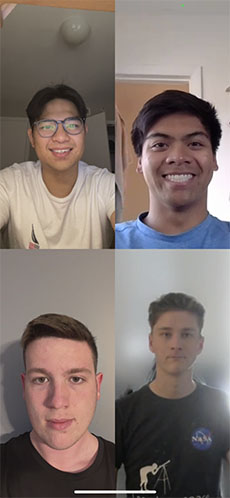 The Feeling of Sight (TFoS)
The Feeling of Sight (TFoS)
Spencer Buchanan, Kauyen (Abel) Chen, Janssen Gamilla, Connor Odum
The Feeling of Sight (TFoS) is a supplemental assistive device intended to give a person with a visual impairment a better feeling of their surroundings. Using multiple distance sensors around the users waist and a haptic feedback system, the user can gauge the distance to obstructions around them. The TFoS system is designed to be unobtrusive to wear and easy to operate. Future additions could include turn-by-turn directions, environment descriptions, and other methods for feedback about the environment.
 United Heartbeats: Application for on Hand CPR Guidance
United Heartbeats: Application for on Hand CPR Guidance
Brady Beggs, Cecilia Besancenez, Yichen Fang, Nachi Rotte
According to the American Heart Association, immediate Cardiopulmonary Resuscitation (CPR) can double or even triple the chance of survival after cardiac arrest. However, most Americans get certified with CPR training and may never revisit it again until a life threatening emergency arises. We are proposing a phone application that will provide CPR guidance in emergency situations. With our android app, millions of Americans will gain access to audio cues and verbal commands regarding chest compression frequency and mouth-to-mouth guidance, among other instructions, for the three main age groups. Ultimately, the goal of this phone application is to increase the efficiency and effectiveness of CPR performed by bystanders in emergency situations to significantly improve the chances of survival in cardiac arrest victims. This app will have a simple and user friendly interface but provide important, life saving information during hectic and unpredictable situations.
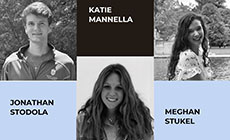 NEMO: Neptune Ecology and Marine Observatory
NEMO: Neptune Ecology and Marine Observatory
Sunken Structures Society: Katelyn Mannella, Jonathan Stodola, Meghan Stukel
The Neptune Ecology and Marine Observatory, NEMO for short, is a partially submerged forward station for marine study, as requested by the National Oceanic and Atmospheric Administration. The NEMO station is a two-story, partially submerged structure located directly off the coast of the Virginia Key, Florida. The station will function as a research center and underwater observatory consisting of laboratories, recreational, and residential facilities to serve NOAA’s need for marine, climate, and oceanic studies. Complete engineering design of the two-story concrete structure was performed by the project team, featuring structural and geotechnical engineering analysis.
 The Skywalk Apartments
The Skywalk Apartments
JAWA Engineering: Abdulrahim Alhajaji, Julie Gaona, Abigail Grunenwald, Warren Radford
JAWA Engineering is designing a mixed-use building to be constructed on the corner of Parnell Street and St. Louis Avenue. The building, Skywalk Apartments, will house 32 apartments in its two upper floors, and 10 commercial units on the ground floor. The primary goal for this project is to design attractive high-quality residences in North St. Louis adjacent to the other developments coming to the area, such as the MLS stadium and the new NGA campus. JAWA Engineering aims to ensure that development occurring throughout the northern parts of midtown continues into adjacent communities that have historically been neglected and forgotten.
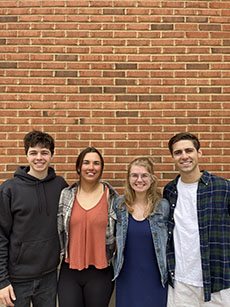 SLU Rooftop Garden
SLU Rooftop Garden
Green Roots: Matthew DiValerio, James Spriggs, Gabbie Kowalik, Mattie Zautner
The SLU Rooftop Garden puts the needs of SLU students and faculty at the heart of the design. Due to the lack of ground area on campus, the idea of rooftop construction was proposed and the roof of Morrissey Hall was selected as the optimal rooftop due to its accessibility, available space, and structural capacity. With the addition of a rooftop hydroponic greenhouse, SLU will be able to use sustainable farming practices to provide fresh fruits and vegetables to the community. Water conservation is made a key element throughout the design by using a closed loop water system in the hydroponic greenhouse and by collecting rainwater for other rooftop plants. A functional and aesthetically pleasing patio space will provide a safe space for students and faculty to enjoy nature and be in community.
Saint Louis University South Campus Tennis Complex
 Gold Medal Design: Abby Cibulka, Adnan Malkoc, Danielle Miller
Gold Medal Design: Abby Cibulka, Adnan Malkoc, Danielle Miller
Gold Medal Design believes in providing state of the art athletic facilities to increase athletic success and saw a need for such facility for the SLU Division I tennis program. The tennis team currently must travel to an off-campus facility to practice and host tournaments; the Gold Medal Design team looks to remedy that with a new tennis facility on SLU’s south campus near the current track complex. The final project design includes six NCAA standard tennis courts, a large grandstand spanning 275 feet for optimal viewing opportunities, and a 10,000 square foot building featuring tennis and track locker rooms for both men’s’ and women’s’ teams.
 Automated Pill Sorting
Automated Pill Sorting
Robert McCormick, Timothy Metzger, Akash Sookun
The goal of the automated pill sorting machine is to improve pharmaceutical drug adherence by providing medications to patients/consumers pre-sorted at the pharmacy. This convenience will provide pharmacies an additional service for their customers while also improving the customers well-being. An additional goal of this project is to provide the product at an affordable price and in a relatively small form factor. The machine functions with the aid of a pharmacy technician loading pills into designated slots so the machine can then sort them into a days of the week bin. To achieve the retrieval and transport of pills several servos and pneumatic devices are used in a way similar to SCARA robotic arms.
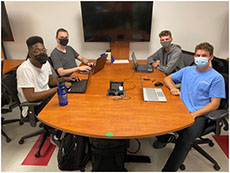
Bicycle Rack on Rapid Transportation
Jordan Barrett-Elder, Joseph Cvelic, Peter Kickham, Jason Rohlfing
Worldwide urbanization has continuously pressured infrastructure to progress to support the masses. Rapid transit systems (trains/subways) carry the most passengers as many find it faster and cheaper than driving a personal vehicle. Bicycles are another efficient form of transportation, especially when travelling small distances (<3 miles). In utilizing both a bicycle and rapid transit, many could commute to and from their jobs in a significantly cheaper, faster, and more sustainable fashion. The purpose of this project is to make use of rapid transit by bicyclists more practical, increasing ridership and relieving stress of cyclists and pedestrians alike. The project deliverables will include a functioning prototype of a single bike rack compatible with a mass transit train car, as well as a project report analyzing the product and how it can impact the rapid transit system and bicycle industry in the United States.
 Desktop CNC Router: Reimagining the Way You Tinker
Desktop CNC Router: Reimagining the Way You Tinker
Emerson Brazile, Nishil Condoor, Robert Selbly, Sean Walsh
In the CNC Router market, there has been a growing base of hobbyists who use these machines to create carvings and engravings made of wood and soft metals. There are several low-budget routers that can be found already, but several problems are prevalent including unreliable system-software integration, frequent device maintenance, and high cost for the product received.With a positive market outlook, a more cost effective and reliable machine is crucial in order to expand the ownership of these machines. Our proposed solution is a tabletop CNC Router that has enhanced portability, durability, and precision compared to that of the current machines.
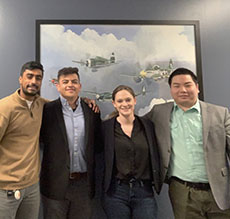 Portable Tri-wheeled Electric Scooter
Portable Tri-wheeled Electric Scooter
TriDent: Jose Acosta, Natalie Egherman, Sal Khan, Michael Luan
Tri-Dent is a three wheeled e-scooter, powered by an electric BLDC hub motor. It
provides a compact mode of transportation that is safe, reliable, convenient and environmentally
friendly.
Tri-Dent is intended to be privately owned and the primary market is adults who commute
short distances (<1 to 5 miles) and are seeking a more practical alternative than
walking or driving.
It features a long lasting battery (h3r run time), a foldable design that allows it
to be carried like a suitcase, and safety features like speed control, disc breaking,
and headlights/horn.
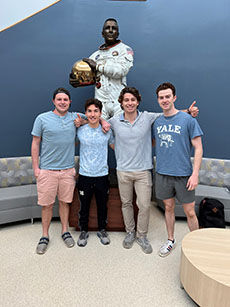 SD01
SD01
Ryan Bjerke, Garret Domash, Barrett Kurmann, Zach Rogers
Our project is centered around the redesign of a racing go kart chassis. There is currently not an American manufacturer that makes a competitive 2-cycle chassis. We have partnered with an industry professional, who has agreed to sponsor our project and aid us in any way he can.
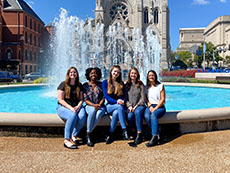 The Deicing Bot
The Deicing Bot
Reagan Anspaugh, Grace Flaherty, Elaina Johnson, Crystal Kimama, Sarah Kirsch
In the United States, ice storms affect millions every year. This problem is only just beginning as ice storms have increased since the arctic is heating up, splitting the polar vortex. Homeowners are not seeing this change as positive as ice usually leaves damage and injuries in its wake. Interviews show homeowners desire to stay inside as much as possible when faced with icy conditions, and they are tired of risking injury. There is a need for a device that has the capabilities to distribute deicing solutions across a property without physical intervention. The device that has been developed is controlled using a remote control, ultimately limiting cold exposure and slip risk for the owner. The battery powered deicing bot can be used on varying terrains, distributing both rock salt and a liquid rock salt solution to avoid dangerous conditions for homeowners.
